When the weather stabilised and after the uncommon April snow started again to look like spring, I went from Banja Koviljača on a short trip to village Tršić, Monastery Tronoša and another village Draginac, all southeast and east of Loznica and close to it.
Meanwhile, my photo-camera broke, so I took photos using my mobile phone with all of its advantages and disadvantages.
To start with, I enjoyed the beautiful landscapes I was driving through.
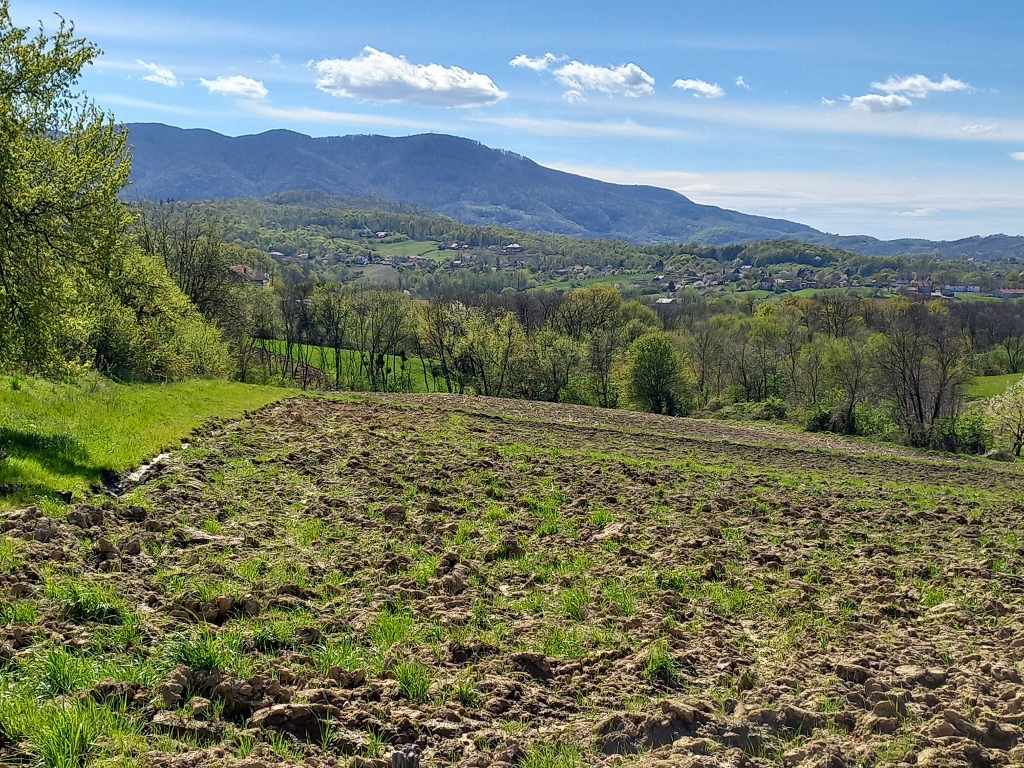 On the way from Loznica to Tršić
On the way from Loznica to Tršić
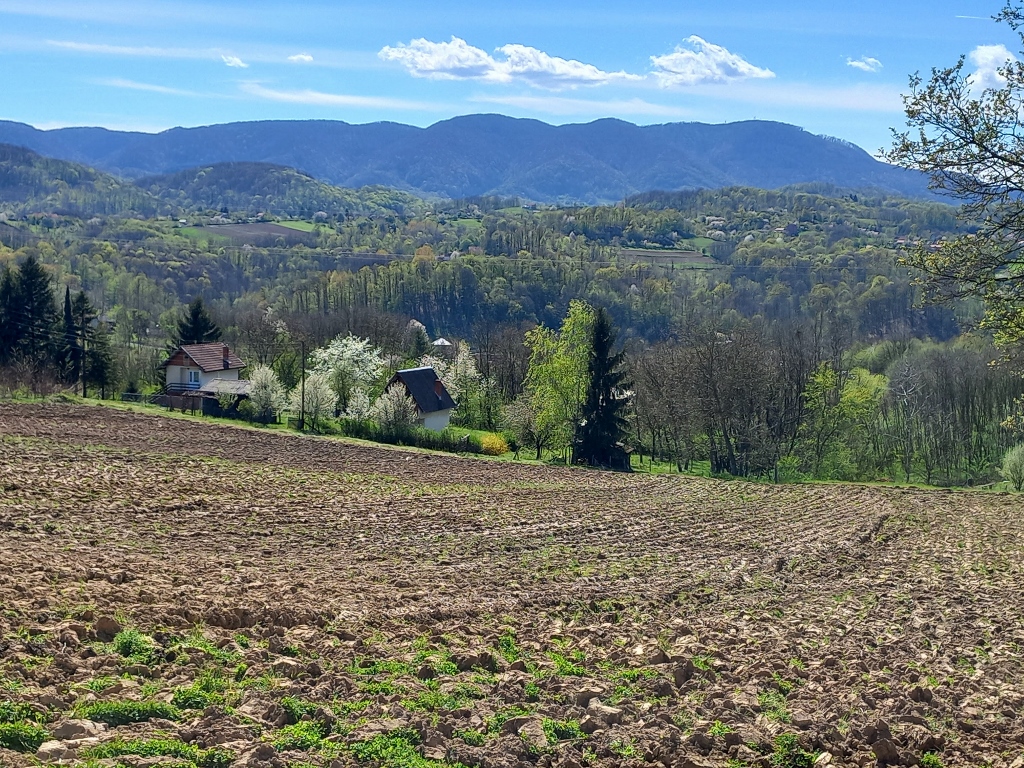 On the way from Loznica to Tršić
On the way from Loznica to Tršić
Since I went on this trip only after the daily therapies I received at the spa, I wondered whether I would get to Tršić (Тршић) on time, while Vuk’s House was still open for visits. As it would turn out – I did not. Yet, this did not prevent me from enjoying a beautiful day and what could be seen and visited. I left my car on a parking lot and headed on foot towards the Memorial House of Vuk Stefanović Karadžić. As I was in a hurry, hoping I would get there in time, I left taking photos for later, so I first started doing this only once I reached this landmark that is, according to the categorisation, of exceptional importance.
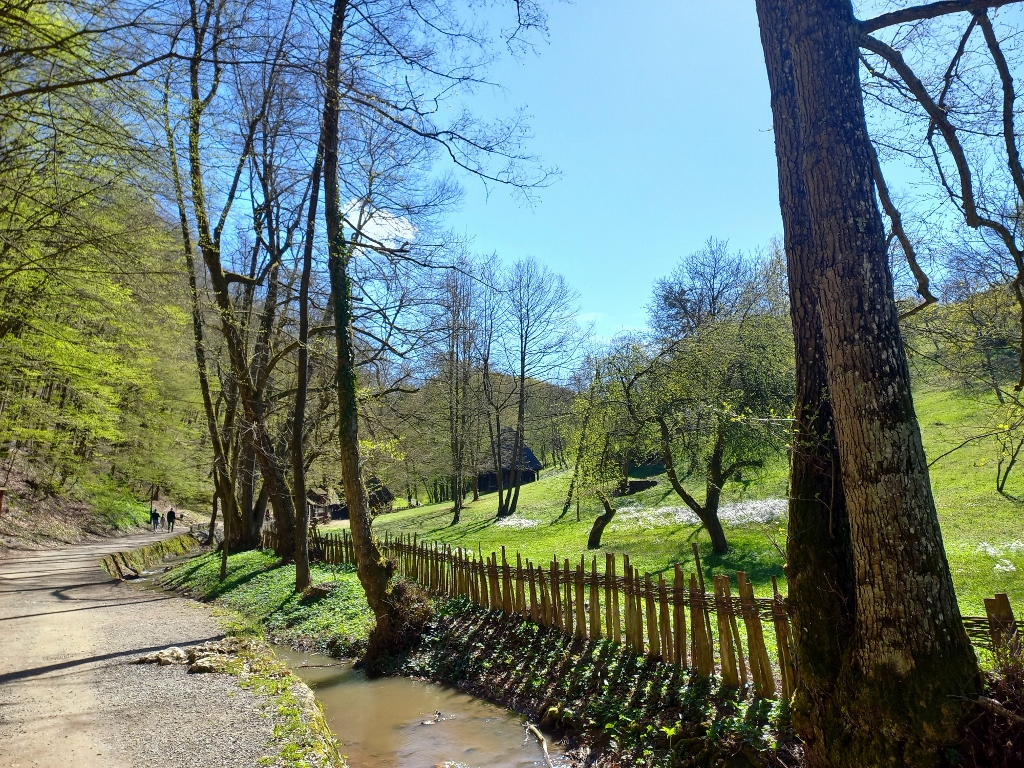 Tršić, a detail
Tršić, a detail
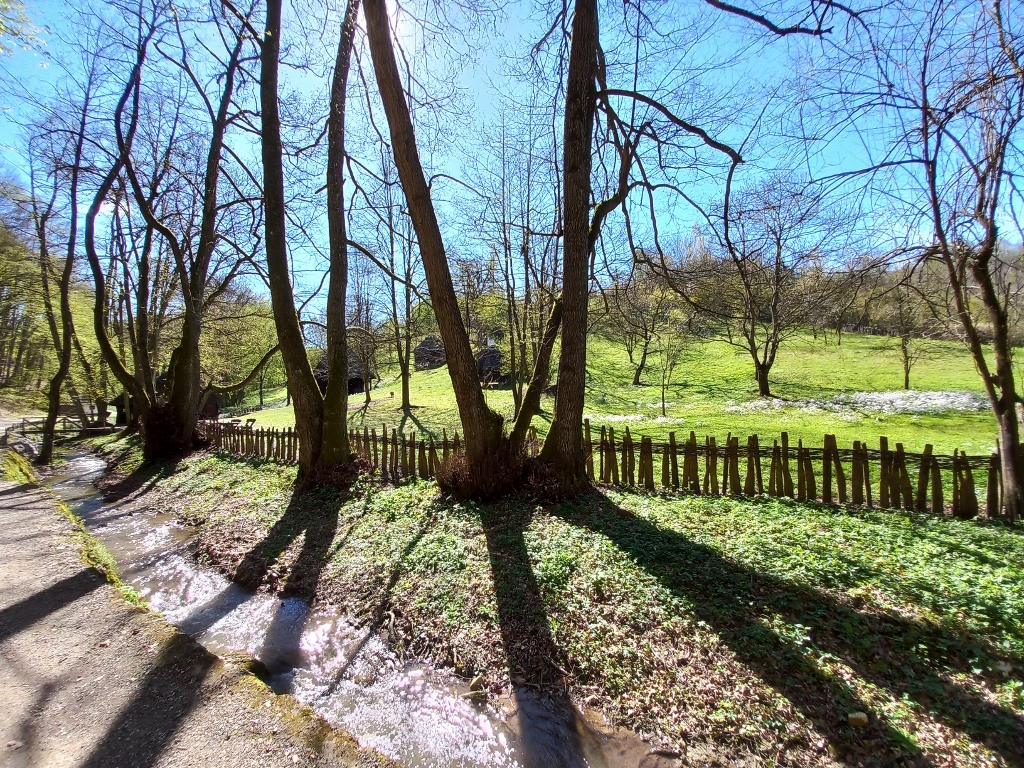 Tršić, a detail
Tršić, a detail
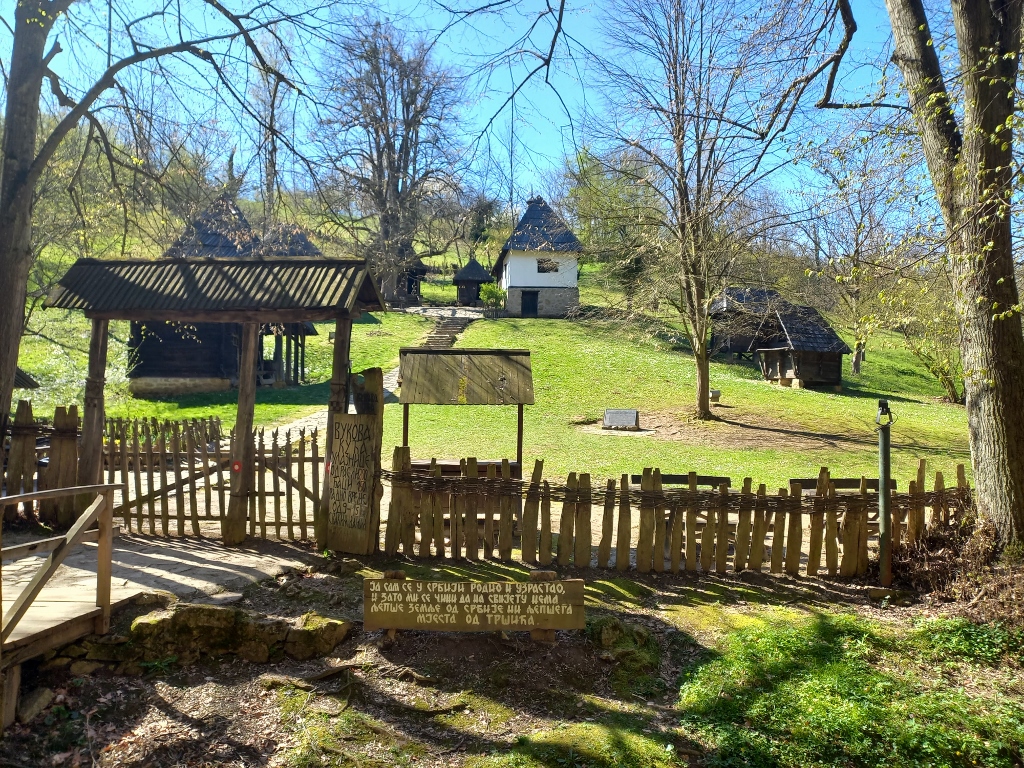 Tršić, a detail
Tršić, a detail
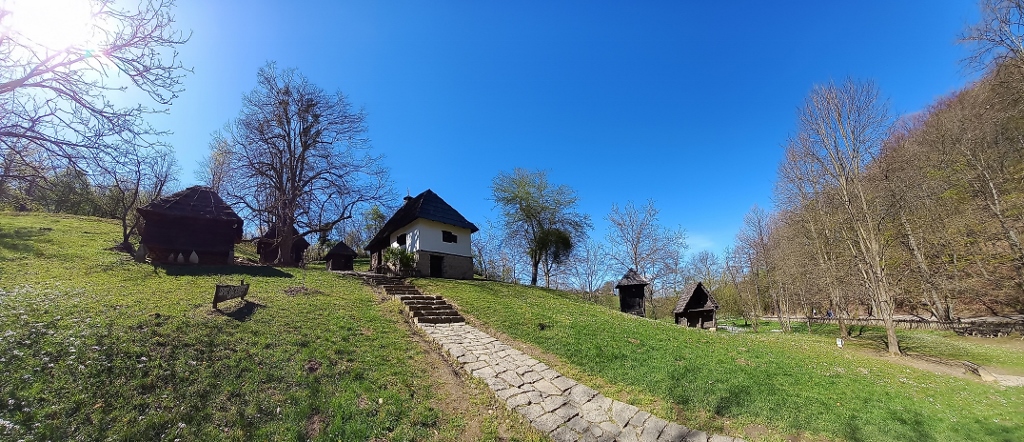 Tršić, a detail
Tršić, a detail
So, here in village Tršić, there is the Memorial House of Vuk Stefanović Karadžić (1787-1864) that is a monument of culture of exceptional importance. I have already mentioned before that Vuk Karadžić is the most influential reformer of the Serbian language and script, as well as an important anthropologist and philologist. He introduced vernacular language into literature and created a phonetic alphabet, while also being the most important collector of Serbian vernacular epic and lyric poetry, fairy-tales, proverbs, sayings, etc.
At the beginning of the 19th century, Vuk rearranged the Serbian Cyrillic script (the first edition of the Serbian dictionary with grammar was published in 1818) which was officially adopted in Serbia in 1868. The main principle is that there are 30 letters for 30 sounds, meaning that once you learn those 30 letters you can write everything that is said in Serbian. Still, as a philologist myself, let me just mention that Serbian is a perfect phonetic language, but not phonemic language, although this is far too technical for me to explain here.
Also, today, Serbian is written both in the Cyrillic script and in the Latin one that became popular during the 20th century and that makes Serbian a completely unique in terms that the same language can be equally written in two scripts. You can transcribe Chinese, and Russian, and Thai and all other languages in, let’s say, Latin script, but they are originally not written in Latin script. For the speakers of Serbian it is basically completely irrelevant which script a text is written in – we read both of them equally fast. There are even jocular versions when letters from the two scripts are mixed. Not a problem for us – we read all of that with ease and often people don’t even realise what the catch is. Human brain is magical!!!
I have been wondering for a while now whether from a neurological side this makes any difference. I don’t know if anybody studies the brain when it moves so easily from one script to another. Maybe this just means that we are weirder than the rest. I would not be surprised.
Although Serbian is written in the Latin script more and more nowadays because of the increased influence coming from the Western culture, I should say that the Latin-script version of Serbian is not equally “perfect” as the Cyrillic one. The examples are letters nj, lj, dž and sometimes dj that do not follow the principle one sound one letter – these two letters are used for one sound each.
When I write these travel stories in Serbian, I use Latin script in order to make the texts easily legible to those outside of Serbia who speak the language (by the way, nowadays, especially because of the political events in the recent times, new “languages” have developed in the Balkans and some of their speakers would not be caught dead using Cyrillic although they could). I feel quite fine with this, since everything else I privately write in Serbian I do using the Cyrillic which I find exceptionally beautiful as a script. I can also touch-type equally fast irrespective of whether my computer keyboard is set to Serbian Cyrillic, Serbian Latin or English. Let me reiterate, the human brain is magical, it just needs to be trained.
But, let me go back to the story about Vuk. I would like to point out yet another interesting thing linked to his work on the script. The famous Irish playwright George Bernard Shaw (1856-1950), the author of the famous “Pygmalion,” left by his will a part of his money for the person who creates phonetic English, precisely having the Serbian Cyrillic script as a paragon. The monies are still waiting idly in an account...
None of this is perhaps surprising, since such trends existed in Europe already in the 18th century. In Serbia, we have all learned that Vuk came up with “Write as you speak, read as it is written,” but according to my recent readings, this principle was in fact created by a German, Johann Christoph Adelung (1732-1806), while Vuk only applied it.
When talking about the links between the European intellectuals and the Serbian language and literature, it needs to be said that at the end of the 18th century and especially in the first half of the 19th century, Europe was engulfed in Romanticism, an artistic and intellectual movement. Among other things, this led to an increased interest in folklore, i.e., the vernacular creations in the broadest sense of meaning. Vuk’s “Grammar of the Serbian Language” from 1818 was translated into German in 1824 by Jacob Grimm (1785-1863), one of the Grimm brothers, who was also a linguist and a philologist.
Vuk moved to Vienna, Austria, in 1813 and there he had an opportunity to meet and cooperate with various intellectuals, while his cooperation with Slovenian linguist Jernej Kopitar (1780-1844) was particularly significant. Thus, already in 1814, Vuk published the first collection of vernacular poems and later there would be more of those.
The interest among the European intellectuals in the folk poetry from the area linguistically covered by the Serbo-Croatian language started already in the 18th century with the famous poem “Hasanaginica” or “The Lamentation of the Faithful Wife of Asan Aga” (as translated by Walter Scott). Although Vuk practically only transcribed this poem into his version of Serbian, this Serbian folk ballade that had been passed on orally from one generation to the next was first written down in 1774 by an Italian travel writer and ethnographer. The poem became exceptionally popular among European intellectuals and so it was translated into German around 1775 by none other than Goethe himself. In 1798, the poem was translated into English by the equally famous Walter Scott and in 1835 it was translated into Russian by Pushkin.
After the publication of the first collection of vernacular poetry, Vuk continued to collect such poems during his travels across the territories of the Serbo-Croatian linguistic realm, thus preserving from oblivion an enormous wealth of the Serbian language and literature.
It is precisely all of this, the huge opus linked to language and literature, that makes the significance of Vuk Karadžić in this domain unsurpassed and that symbolically makes Tršić, as his place of birth, exceptionally important.
Vuk was born here in 1787, but let me say right away that the house that can be seen here today is not the actual house of his birth, but rather it was built here in the place of the original house.
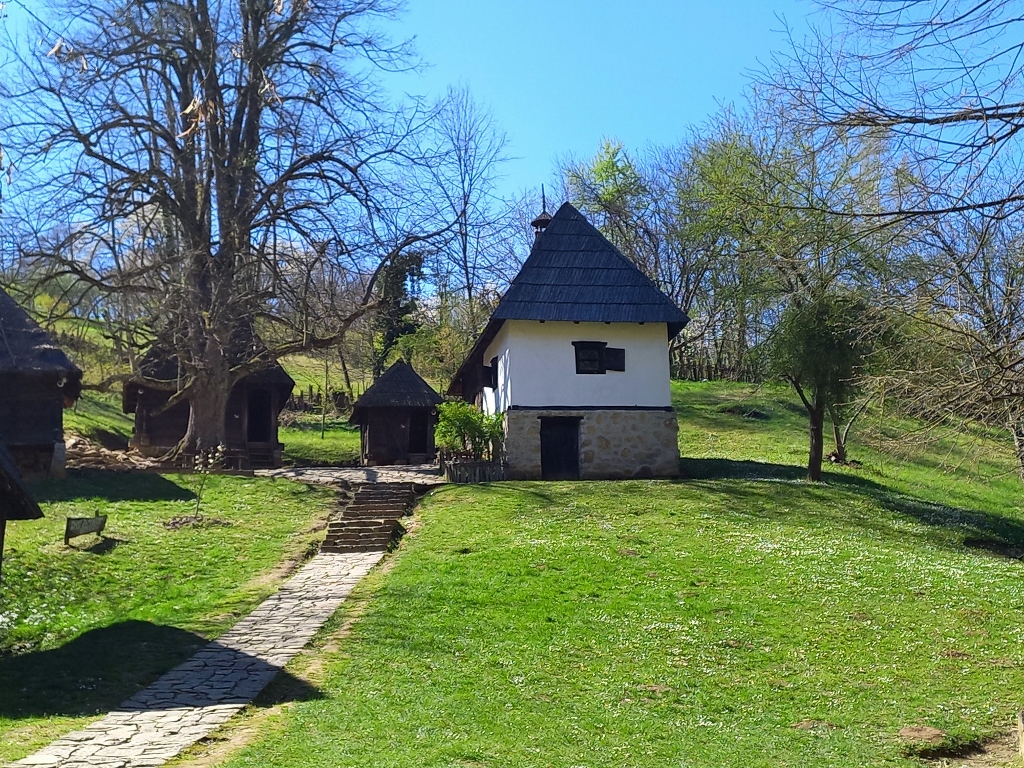 Memorial House of Vuk Stefanović Karadžić
Memorial House of Vuk Stefanović Karadžić
Together with this house built in line with the traditional houses from the Jadar region, there are several smaller wooden structures that can be seen on this plot of land and that were traditionally used by households.
I’m not going to go into all details about Vuk’s life, because who does not know the details or wants to find out more can do so on the internet. What I want to say here is that this whole area, together with the area around Tronoša Monastery, where Vuk was schooled for a short while and where I drove to later on, has been declared a landscape of exceptional features named “Tršić-Tronoša Cultural Landscape.”
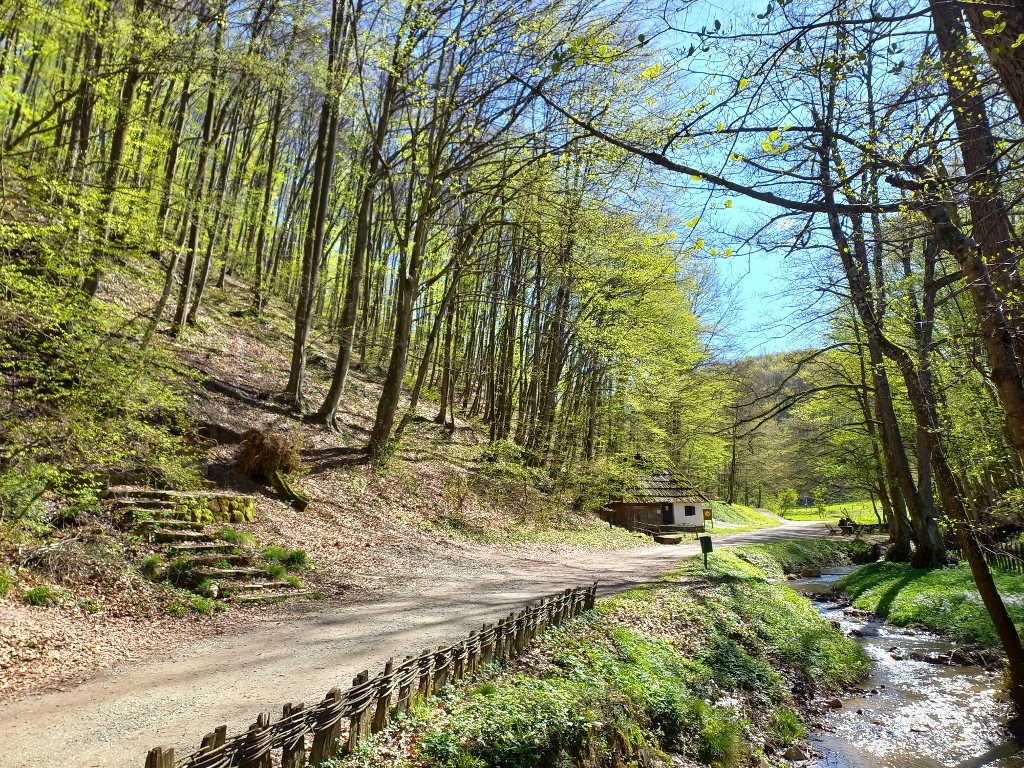 Tršić, a detail
Tršić, a detail
The visitors can also walk or ride a bicycle to the monastery, since there are trails. If I had more time, I would have certainly done this, but because of the specific limitations, the walk through the “Tršić-Tronoša Cultural Landscape” would have to wait for some other time.
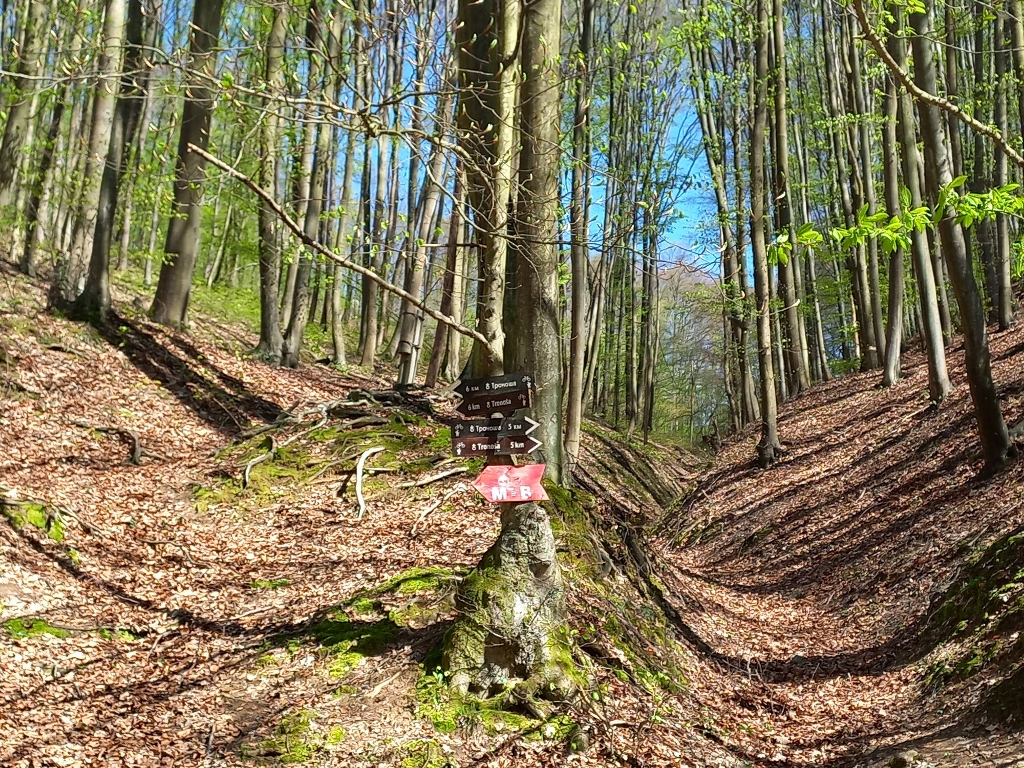 Tršić, signs for hikers
Tršić, signs for hikers
Since I had no intention to walk to Tronoša Monastery, I started to head back towards the parking lot where I had left my car, while taking note of various interesting things along the way.
For instance, not far from the estate where Vuk’s memorial house is, I noticed something that, by now quite seriously, started to make me think that people from west Serbia have an innate need and proneness to create pieces of contemporary conceptual art. I have already shown before (https://svudapodji.com/en/banja-koviljaca-4/) an “unofficial open-air museum of contemporary art” with windshields that I saw in Banja Koviljača. Here I first saw – a bicycle. By itself, the bicycle did not seem special at all, but the place where I noticed it certainly surpasses the daily use and parking of bicycles. Somebody has gone to a great deal of trouble to place it where it is.
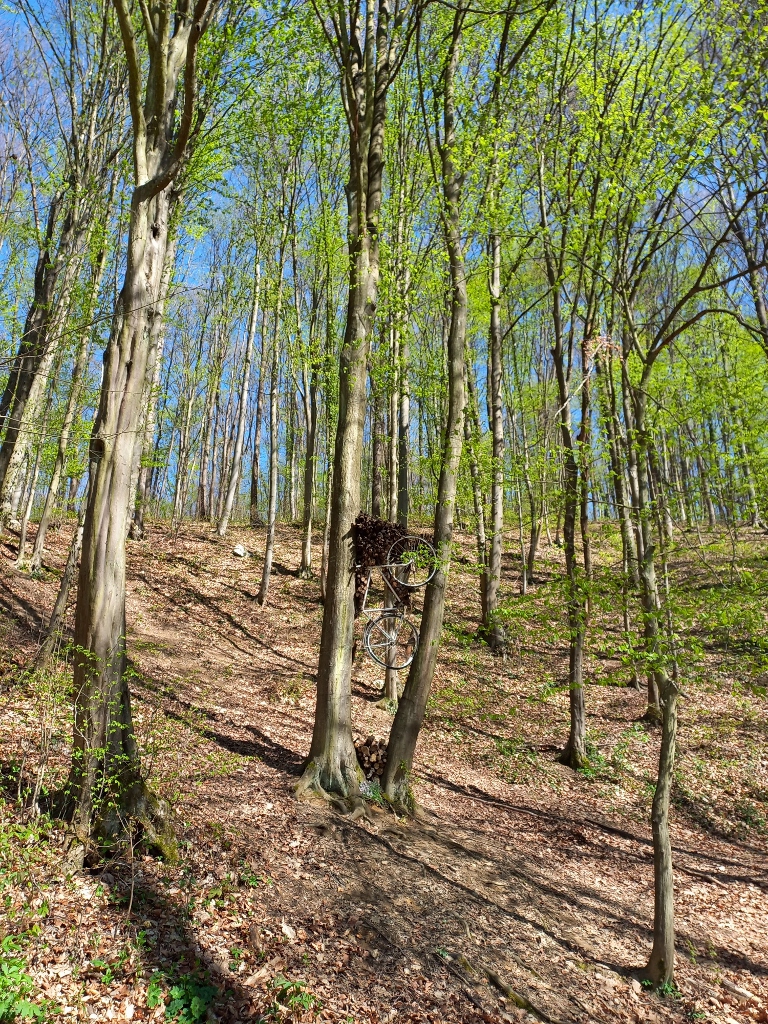 Tršić, an exhibit in yet another unofficial museum of contemporary art
Tršić, an exhibit in yet another unofficial museum of contemporary art
And then, a little farther on, I noticed yet another “installation.” Again, somebody did try to introduce another interesting element into nature. I really love nature, especially when it is wild and intact, but here people have already made the road and other things, so why not make a “piece of art” as well?
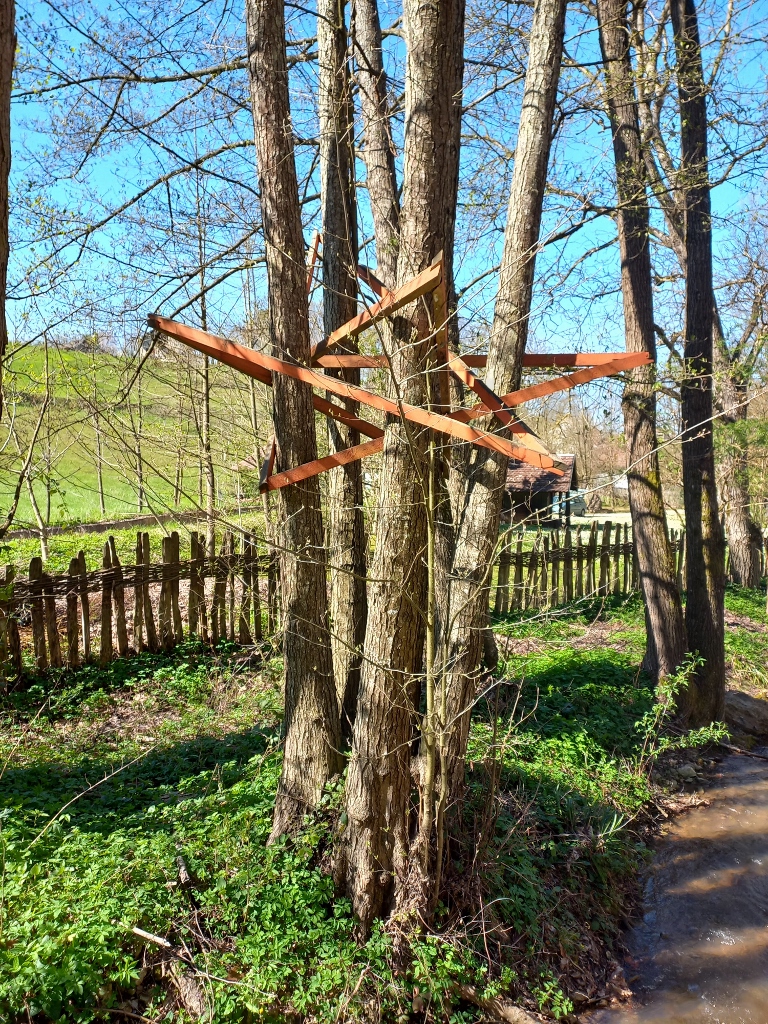 Tršić, an exhibit in yet another unofficial museum of contemporary art
Tršić, an exhibit in yet another unofficial museum of contemporary art
But, the stroll itself, now relaxed because I was in no particular hurry, was also beautiful and enabled me to enjoy various details I was surrounded with.
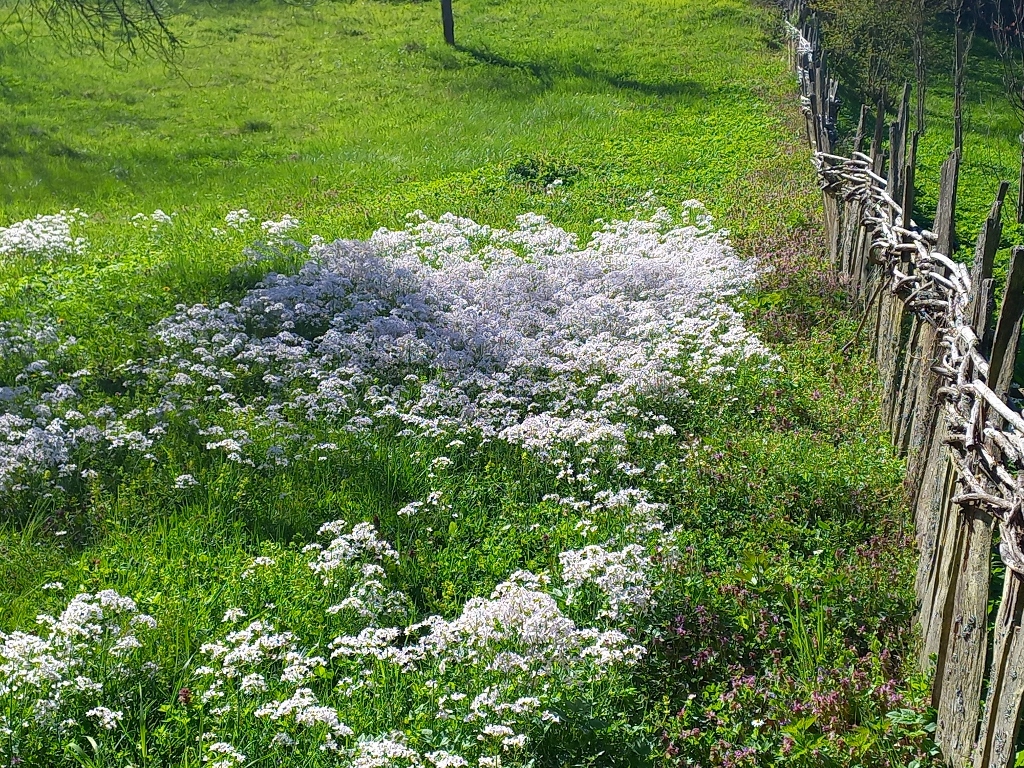 Tršić, a detail
Tršić, a detail
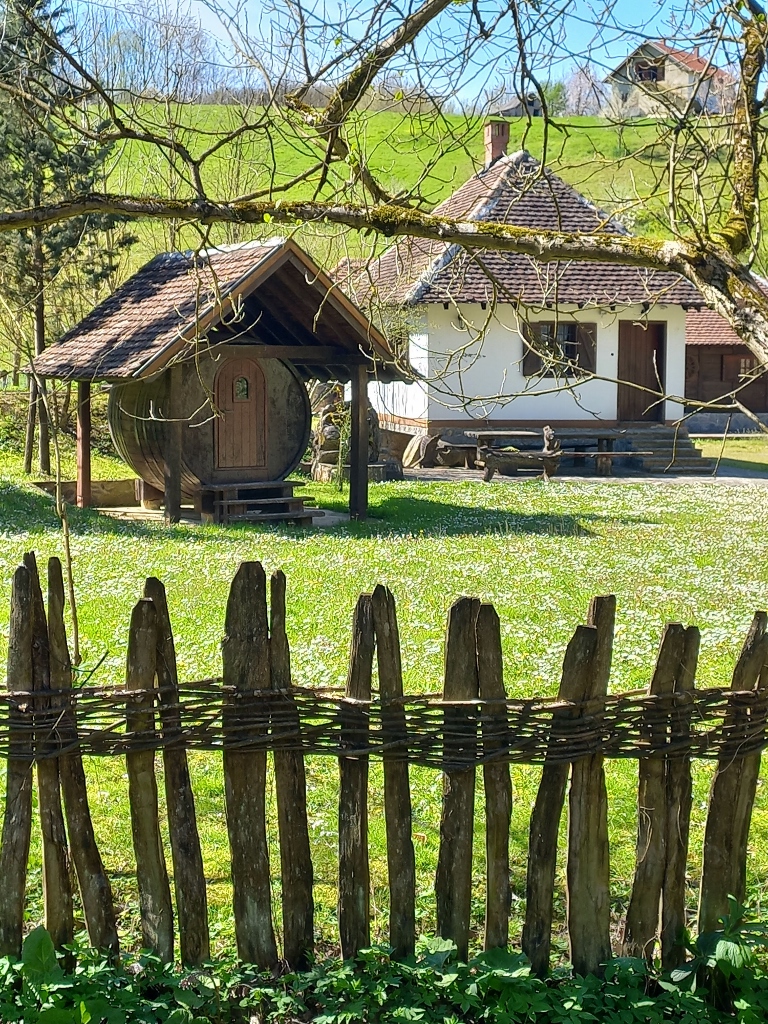 Tršić, a detail
Tršić, a detail
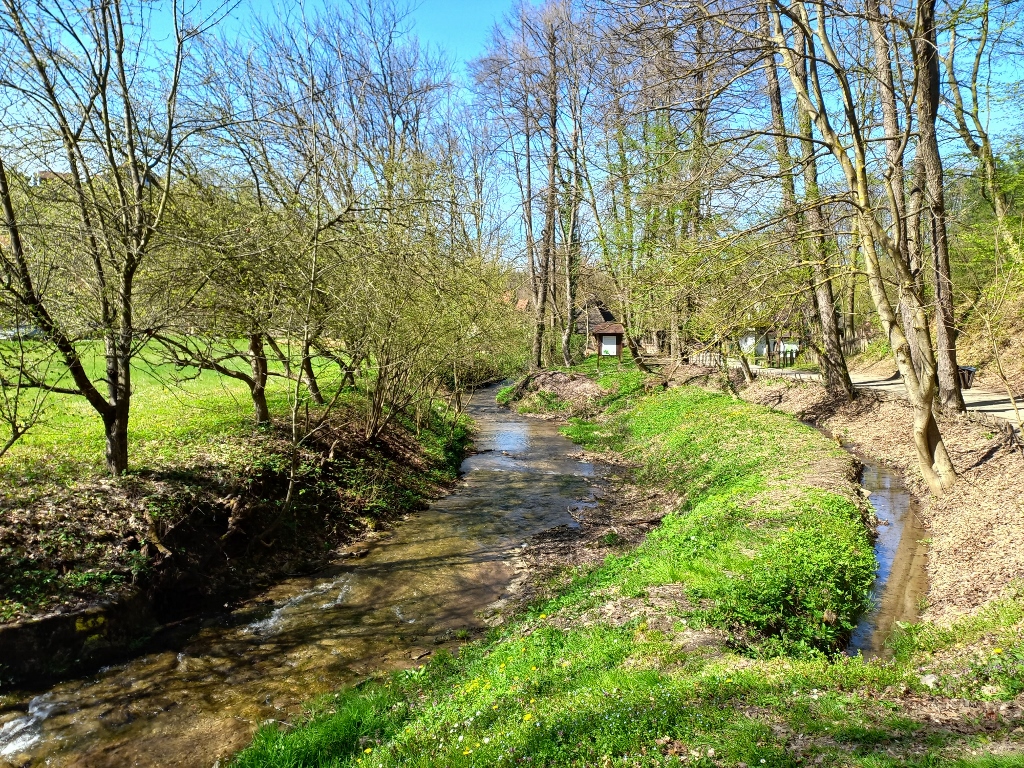 Tršić, a detail
Tršić, a detail
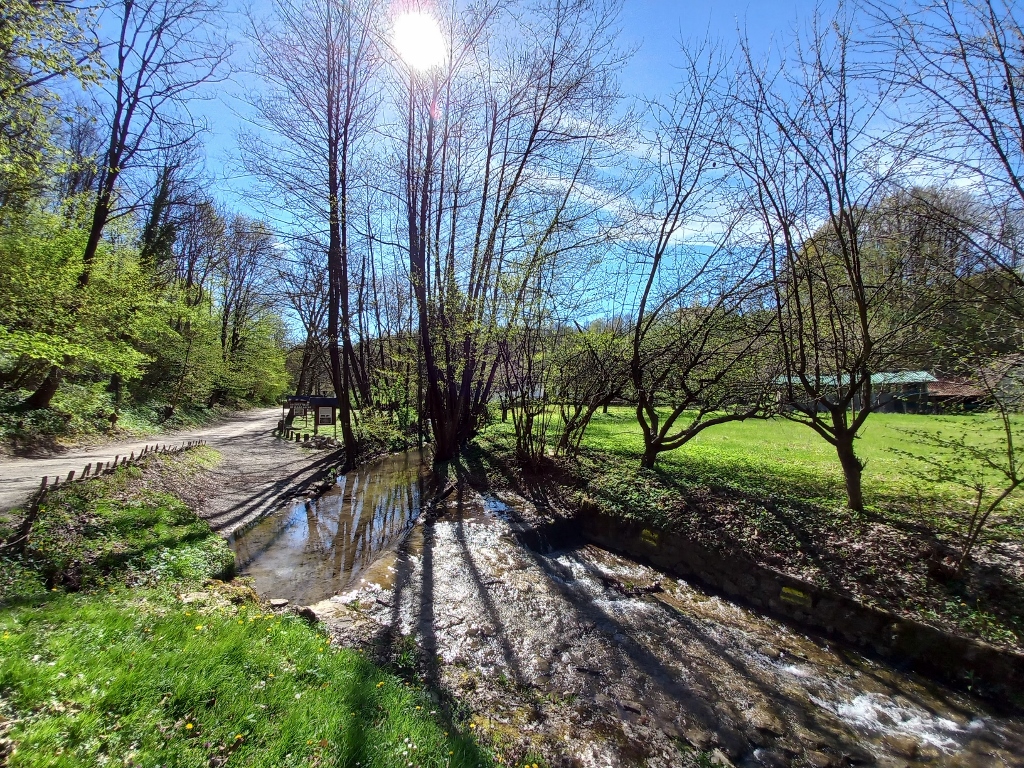 Tršić, a detail
Tršić, a detail
Beside the wide path there is also a traditional watermill from 1920. Admittedly, the original mill that was transferred here in 1964 was destroyed in a fire two years later, but it was completely restored in 1987 and has been operational ever since. It is characterised by a roof covering made of wooden tiles arranged in the beaver-tail style.
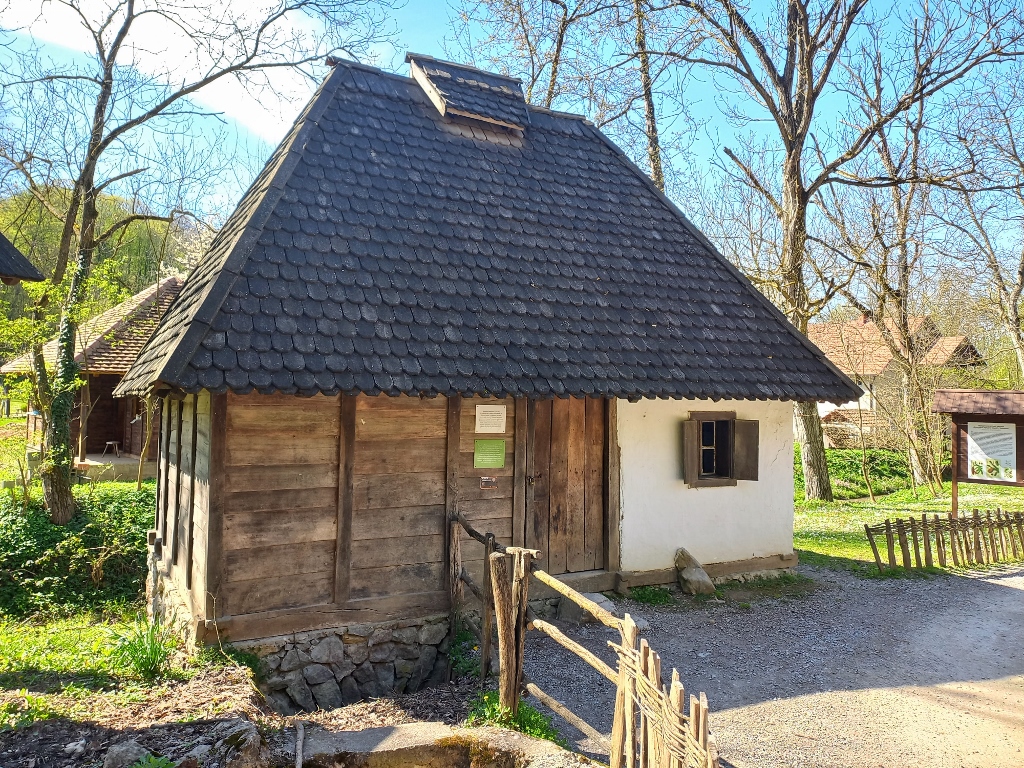 Tršić, a detail
Tršić, a detail
On the other side of the wide path, there is a complex called Saborište (meaning Assembly Venue) where several traditional structures can be seen, as well as a simple amphitheatre since this is the venue where Vukov sabor (Vuk’s Assembly) takes place every year in September.
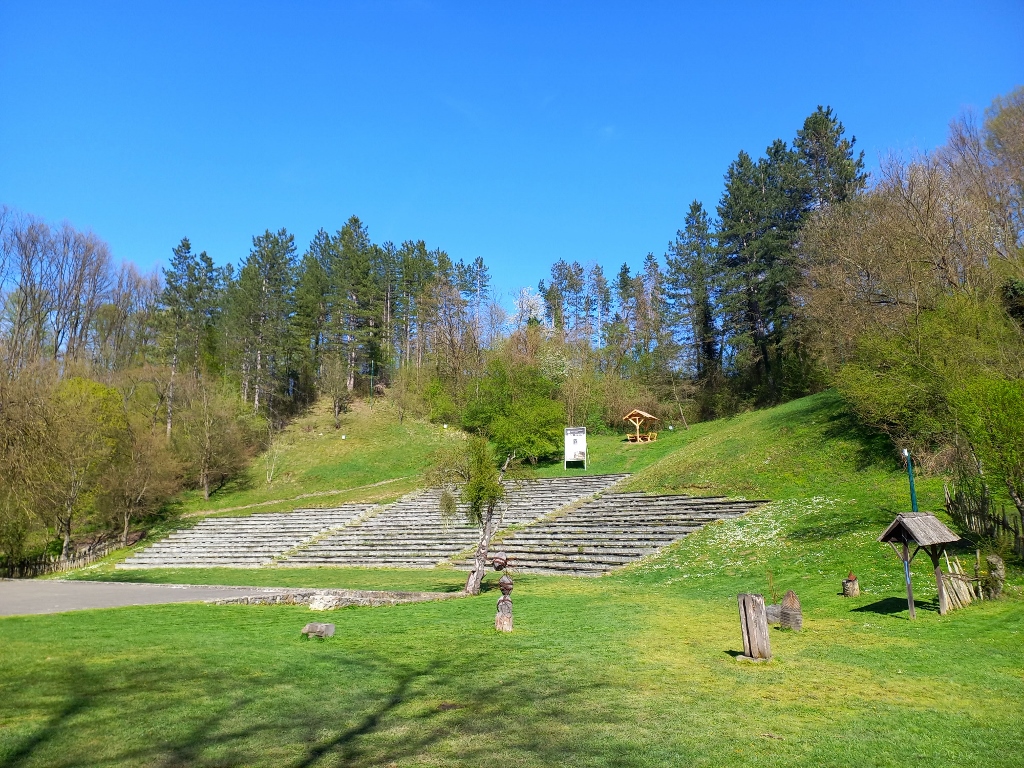 Saborište in Tršić, a detail
Saborište in Tršić, a detail
Namely, each year since 1933 (with the exception of the WWII period), around the middle of September, this is the venue of Vukov sabor, the biggest cultural event in Serbia. The idea is that people gather at this time, like when friends and family gather as guests for family saint’s day and other celebrations. Here, however, the main topic is keeping the memory of the life and work of Vuk Karadžić, while the programme of the Sabor includes art exhibitions, concerts and theatre plays, literary and film evenings, as well as book promotions, etc. Because of all of this, Vukov sabor is inscribed in the list of intangible cultural heritage of Serbia.
As for the Saborište itself, it was formed in 1964 when the stage and the auditorium were built and over time this area has also been turned into an open-air vernacular architecture museum that includes several structures from the beginning of the 20th century.
On each of these structures there is a small plaque that provides data about the structure, but several of them are the same or similar by the type, so I will not write about each one of them separately.
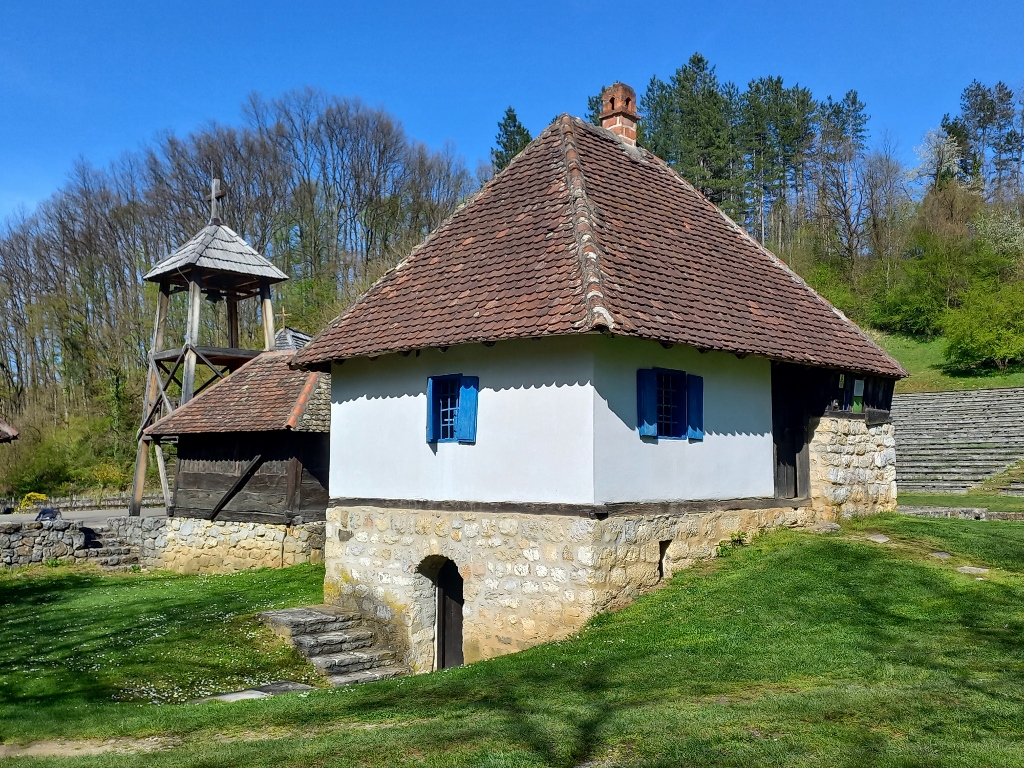 House from 1916 from the area around the town of Valjevo
House from 1916 from the area around the town of Valjevo
The bell tower was built in 1994.
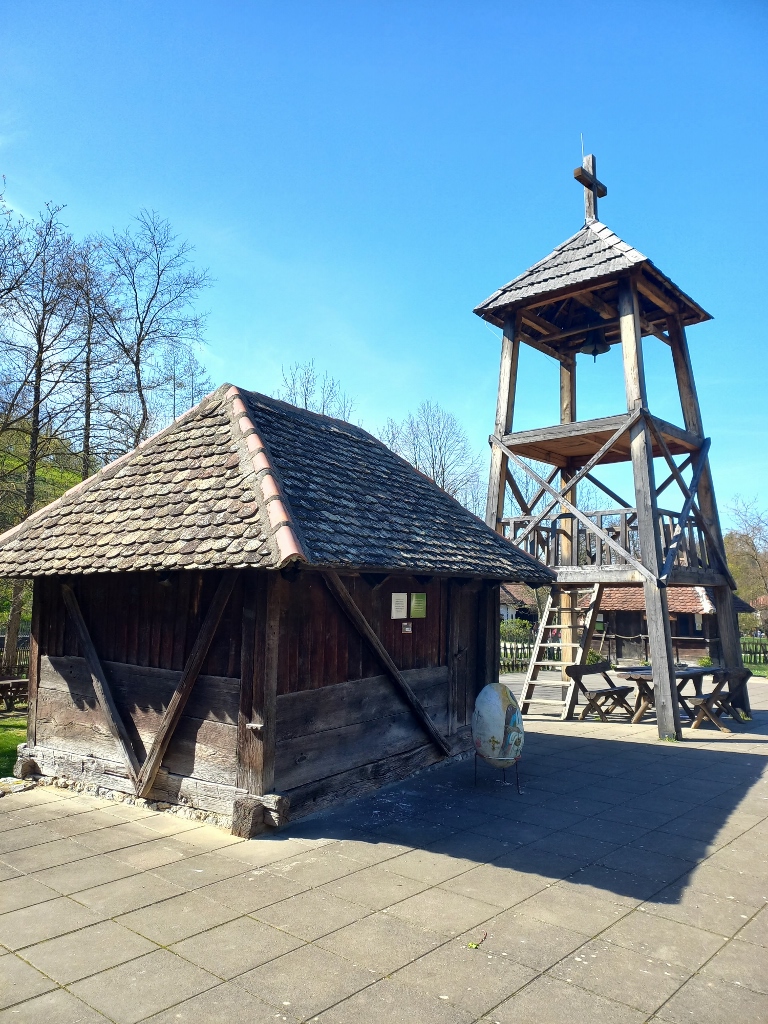 Vajat from 1914 from the village of Trbosilje (Jadar)
Vajat from 1914 from the village of Trbosilje (Jadar)
By the way, vajat (meaning cottage) is a traditional smallish wooden house with no windows that used to be built in the yard of a family property. It had a dual role. On the one hand, it was used as pantry for tools and fruits, and on the other hand, it was used as the room for a young married couple. Namely, it was quite common that several generations lived in one single house that would not be particularly big and the families used to be much bigger (although the mortality rates among children and women giving birth were significantly higher than today). However, young married couples would have the privilege to withdraw to their own vajat at night that would usually be built a little farther from the main house.
The vajats are simply built structures, but some of them were also nicely decorated, such as the one the details of which can be seen in the photo below. It was built in 1920 in the village of Gornje Nedeljice (Jadar).
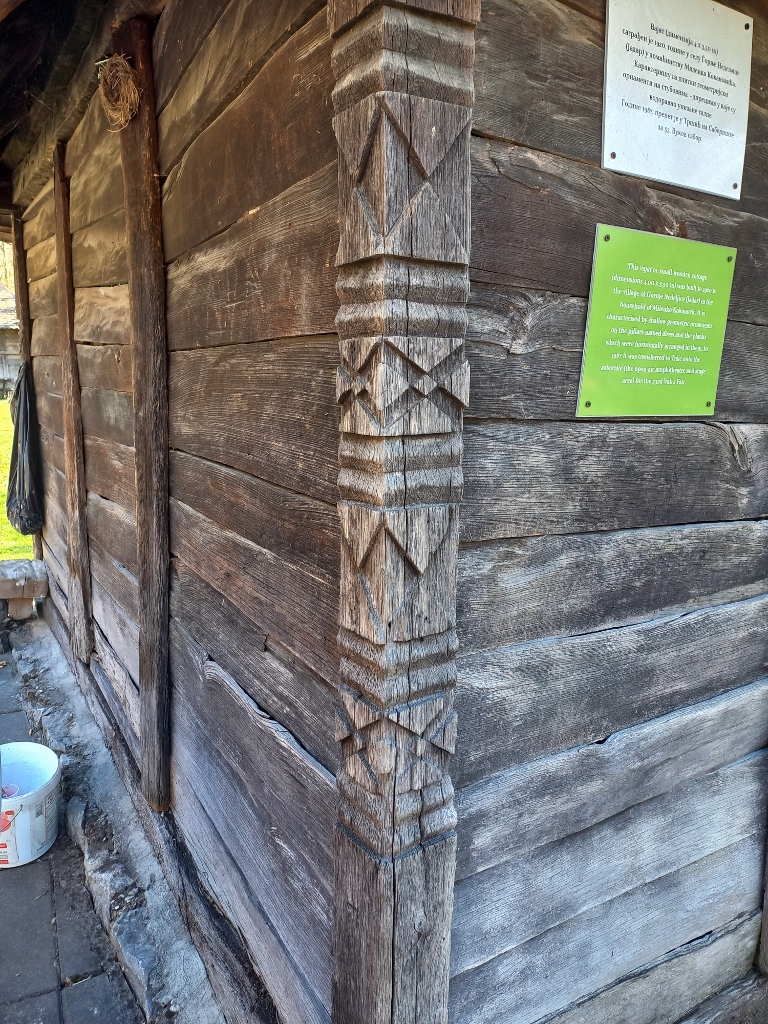 Vajat from 1920, a detail
Vajat from 1920, a detail
At the beginning of the 21st century, the wooden Church of Holy Archangel Michael was built within the Saborište. In other words, this is quite a new structure, but it was made in a traditional style following the paragon of the churches built at the time when Vuk was alive.
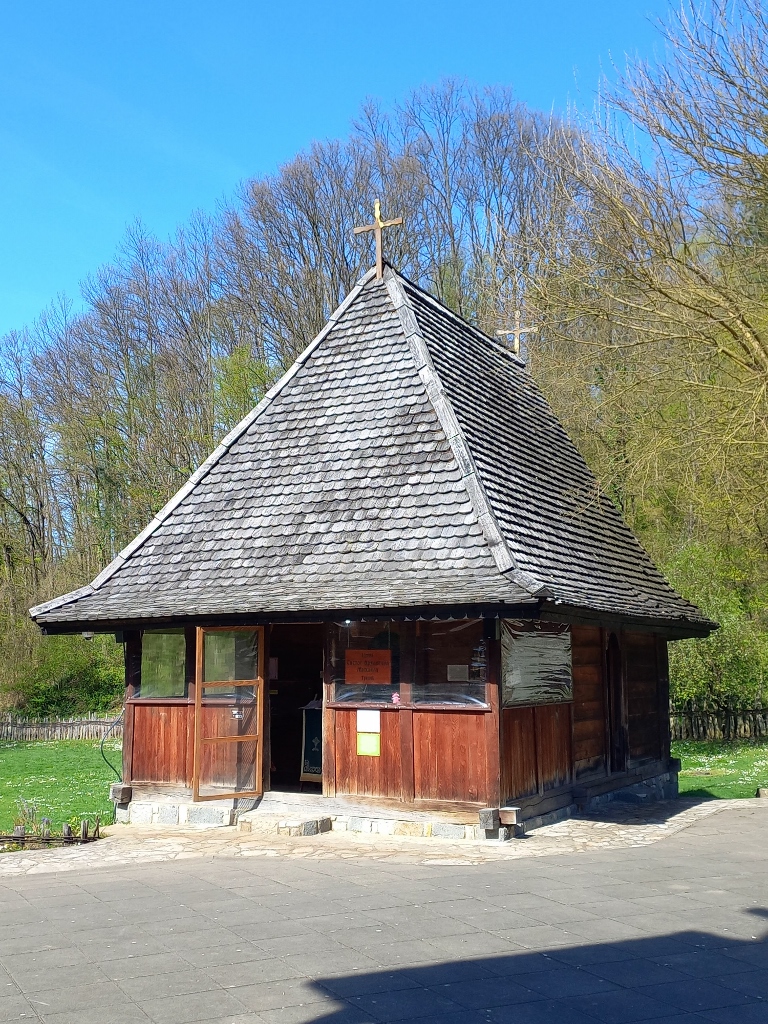 Wooden Church of Holy Archangel Michael in Tršić
Wooden Church of Holy Archangel Michael in Tršić
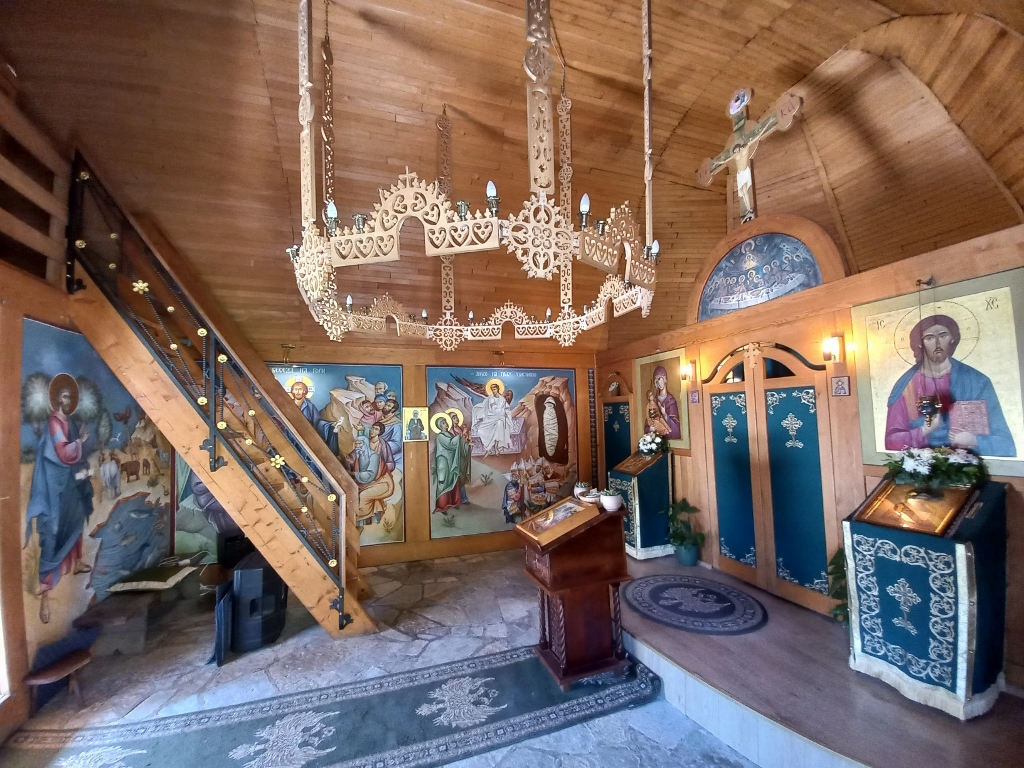 Wooden Church of Holy Archangel Michael in Tršić, the interior
Wooden Church of Holy Archangel Michael in Tršić, the interior
I found it particularly interesting when I saw a ladder here beside which there was a text that quoted several verses from different religious books, all of which suggested that we go towards the God upwards. Thus, on the ladder you can see different stages on the way to God:
Obedience – Repentance – Purity – Prayer – Tameness – Heartsease – Reasoning – Contemplative Silence – Spiritual Pasionlessness – Faith, Hope, Love
Although I am not a practicing Christian, I found this interesting as a reminder for living. I could certainly do with “heartsease” (especially when I’m driving). But, to start with, irrespective of the religion to which one belongs or not, one should contemplate about these elements and measure one’s own life in relation to them. I guess, it cannot hurt.
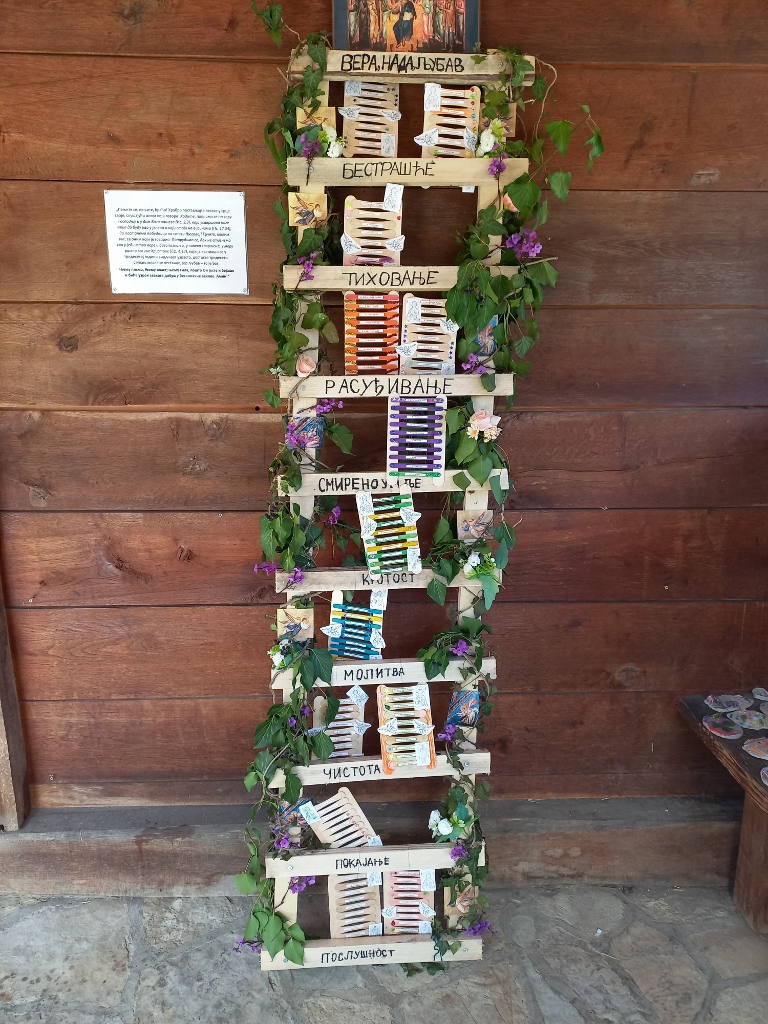 Wooden Church of Holy Archangel Michael in Tršić, a detail
Wooden Church of Holy Archangel Michael in Tršić, a detail
There are various other cute details around Saborište and I walked around for a short while, after which I continued towards the parking lot where I had left the car.
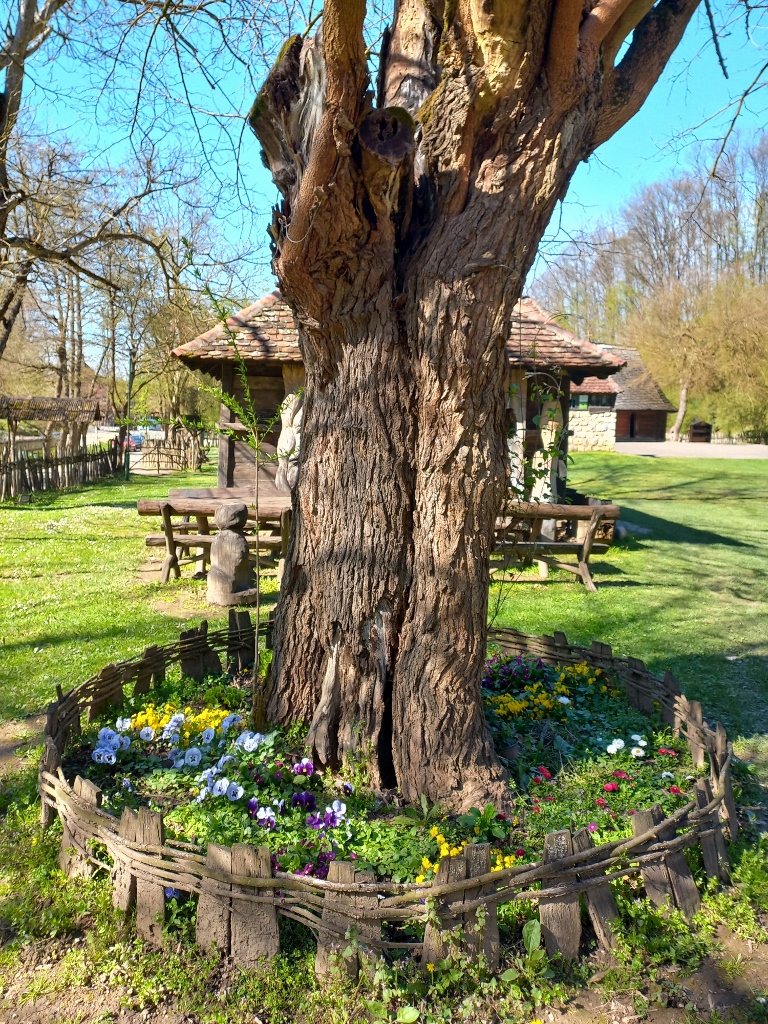 Saborište in Tršić, a detail
Saborište in Tršić, a detail
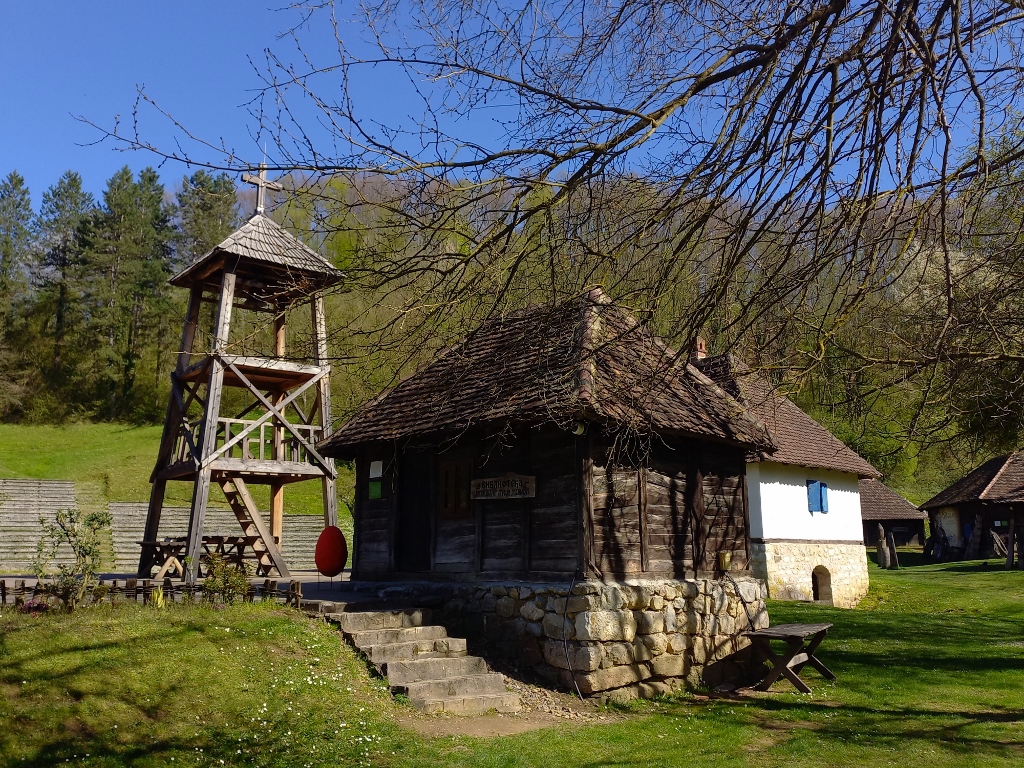 Saborište in Tršić, a detail
Saborište in Tršić, a detail
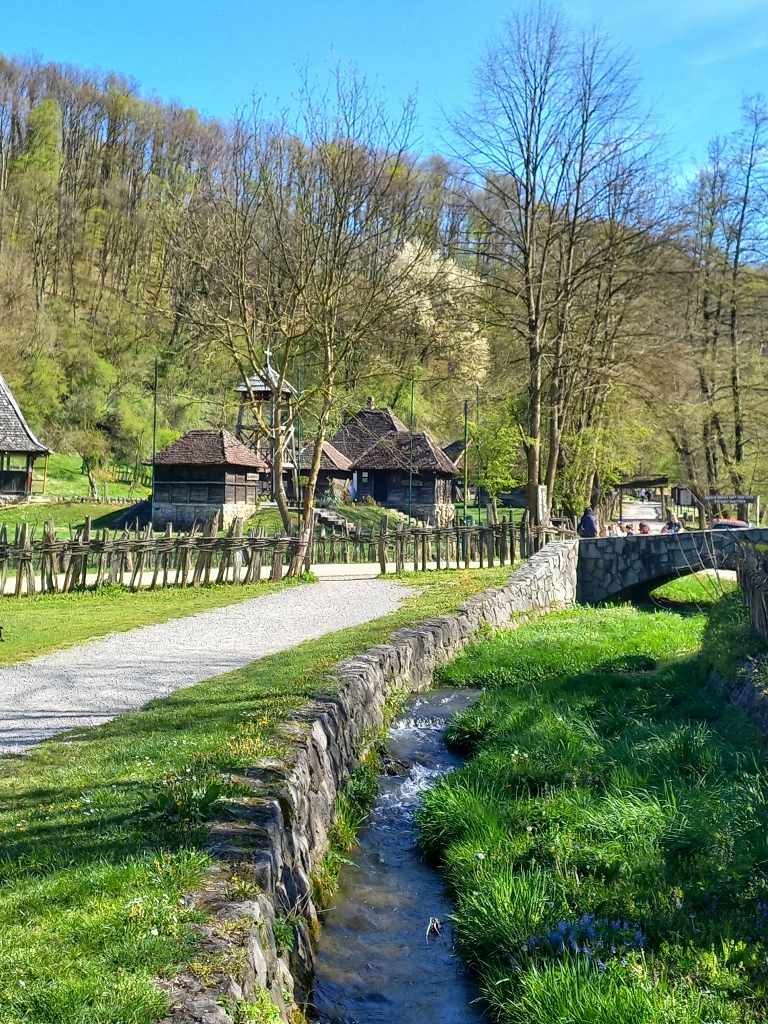 Tršić, view at the Saborište and a stream
Tršić, view at the Saborište and a stream
In one section I also passed by a broad meadow and I was very glad when I noticed a family and a couple of young people who were taking advantage of a beautiful day by playing there.
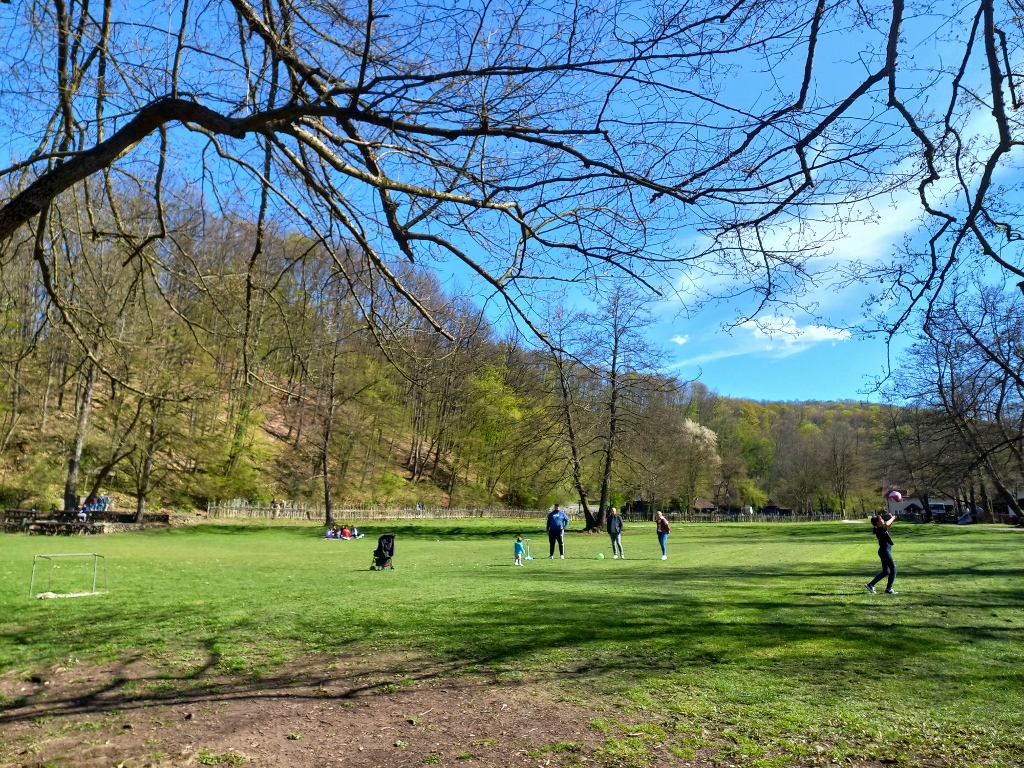 Tršić, a detail
Tršić, a detail
But, there is also a place here where one can make a break in order to eat or drink something. I still felt full from the lunch I had in Banja Koviljača, but that did not stop me from taking a photo of a grill belonging to a restaurant that operates here. Regardless of who eats what at their home, when they go to a restaurant, the Serbs prefer grilled meat.
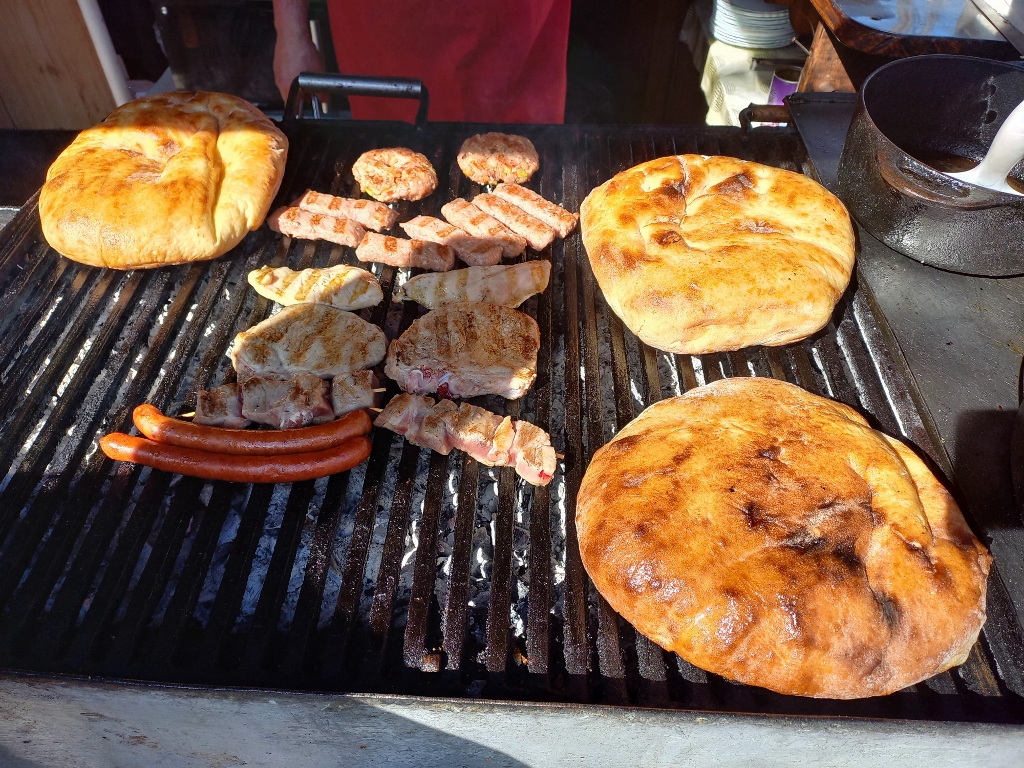 Tršić, a detail
Tršić, a detail
There was a myriad of other picturesque details here, but soon I reached my car and I could continue with the trip.
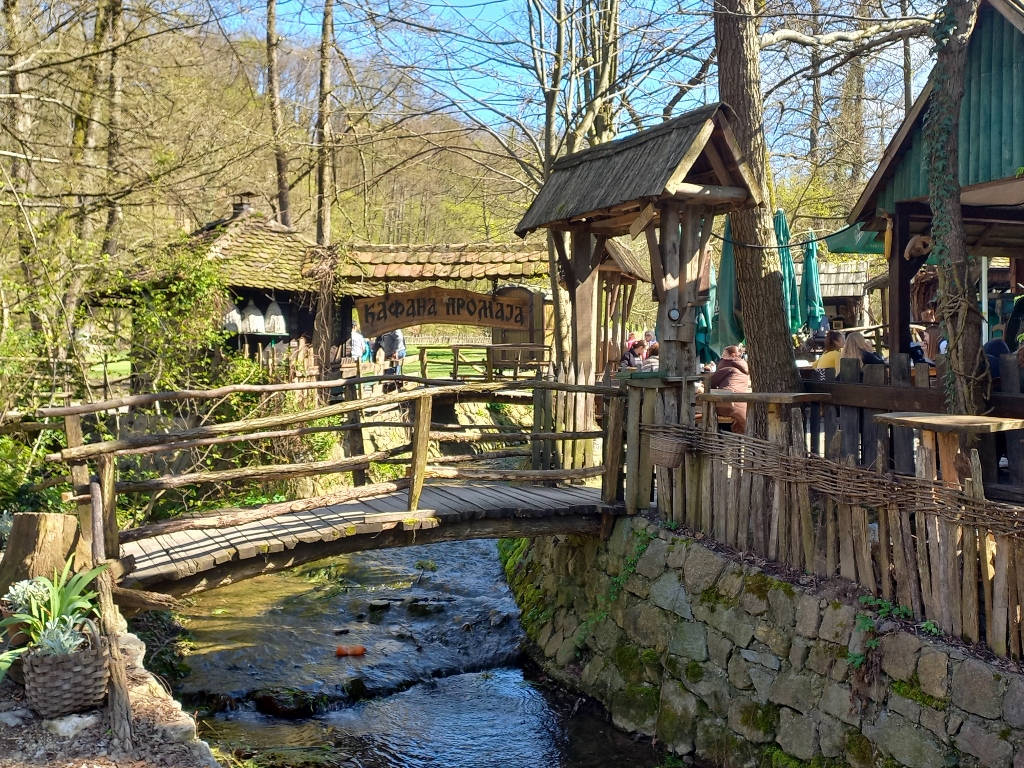 Tršić, a detail
Tršić, a detail
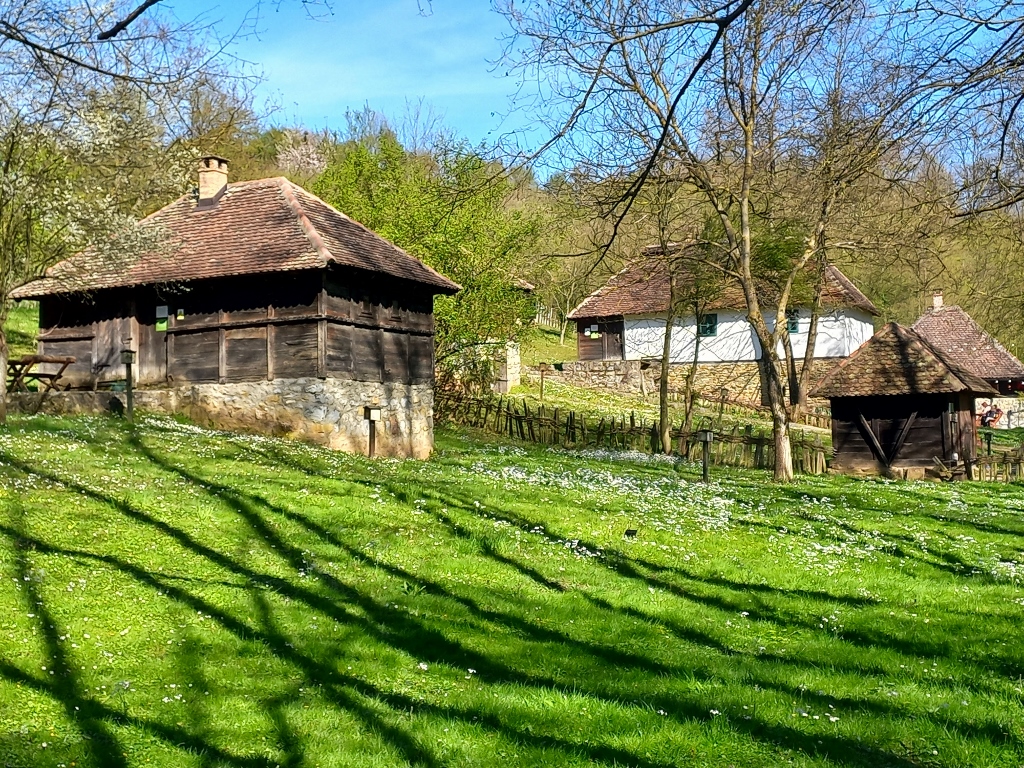 Tršić, a detail
Tršić, a detail
I headed for Tronoša Monastery, but along the way I drove past a restaurant that also offers cottages for the accommodation of guests, while having “ethno-village” as a part of its name. I was still not hungry, but it was a lovely sunny day, so I stopped here in order to have a coffee break.
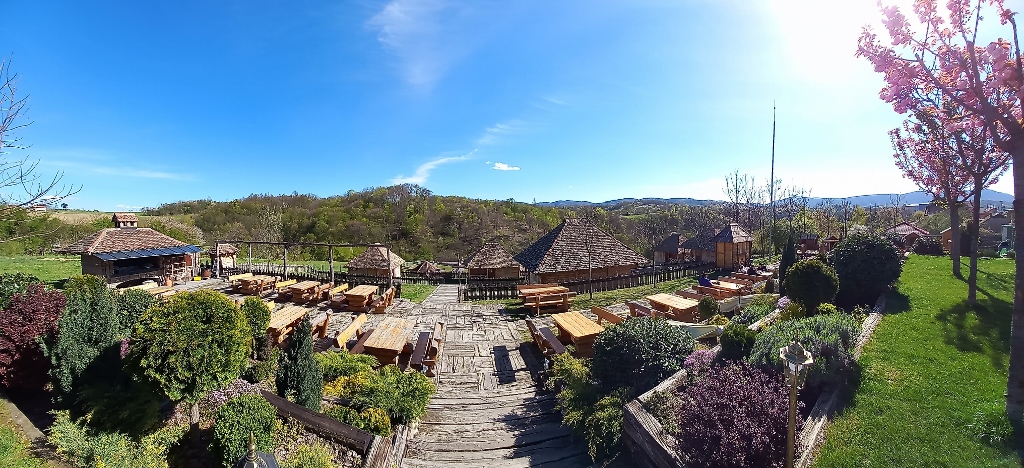 “Ethno-village” on the way from Tršić to Tronoša Monastery
“Ethno-village” on the way from Tršić to Tronoša Monastery
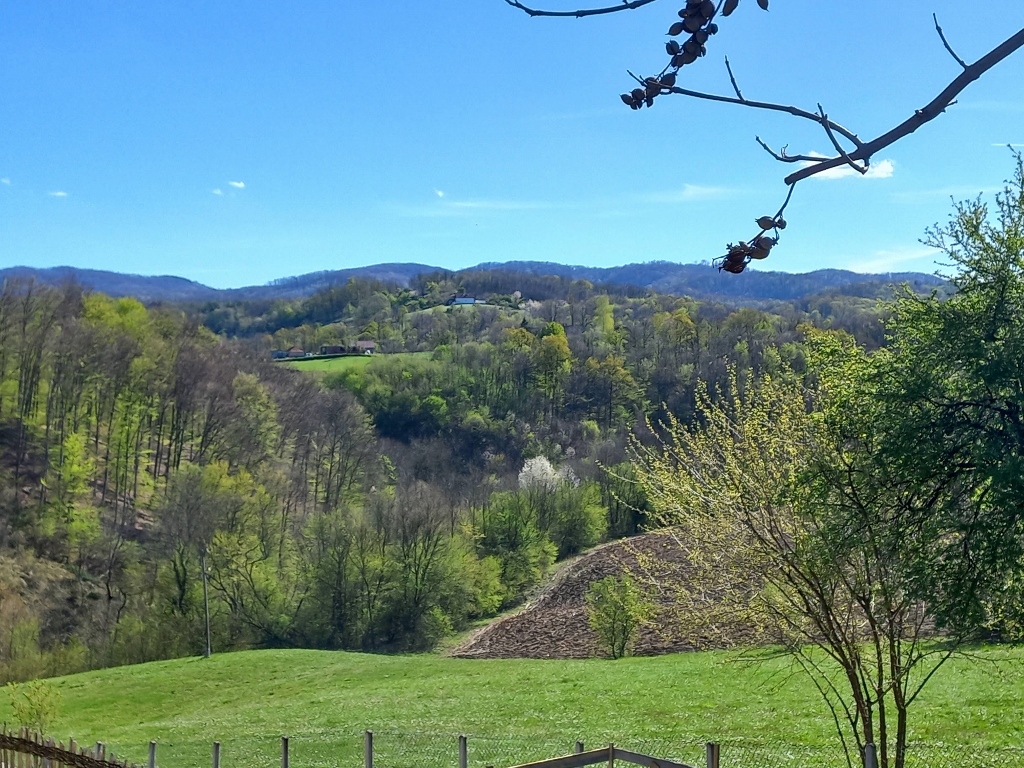 Landscapes between Tršić and Tronoša Monastery
Landscapes between Tršić and Tronoša Monastery
While sitting there idly, enjoying the fine weather, I noticed a blossoming peach tree and then I wondered why we all admire Japanese cherry blossoms when our peach blossoms are also magnificent.
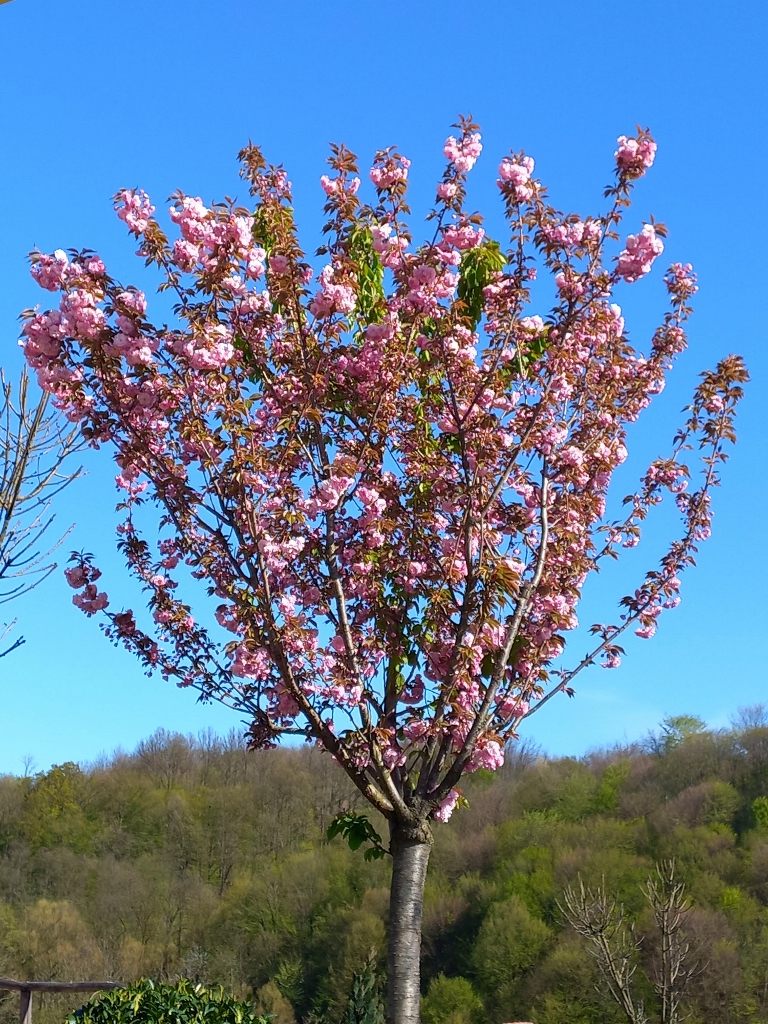 Blossoming peach tree
Blossoming peach tree
On my way to Tronoša Monastery I continued to enjoy the beautiful landscapes and as there were not many cars on the road, I could often stop without bothering anybody.
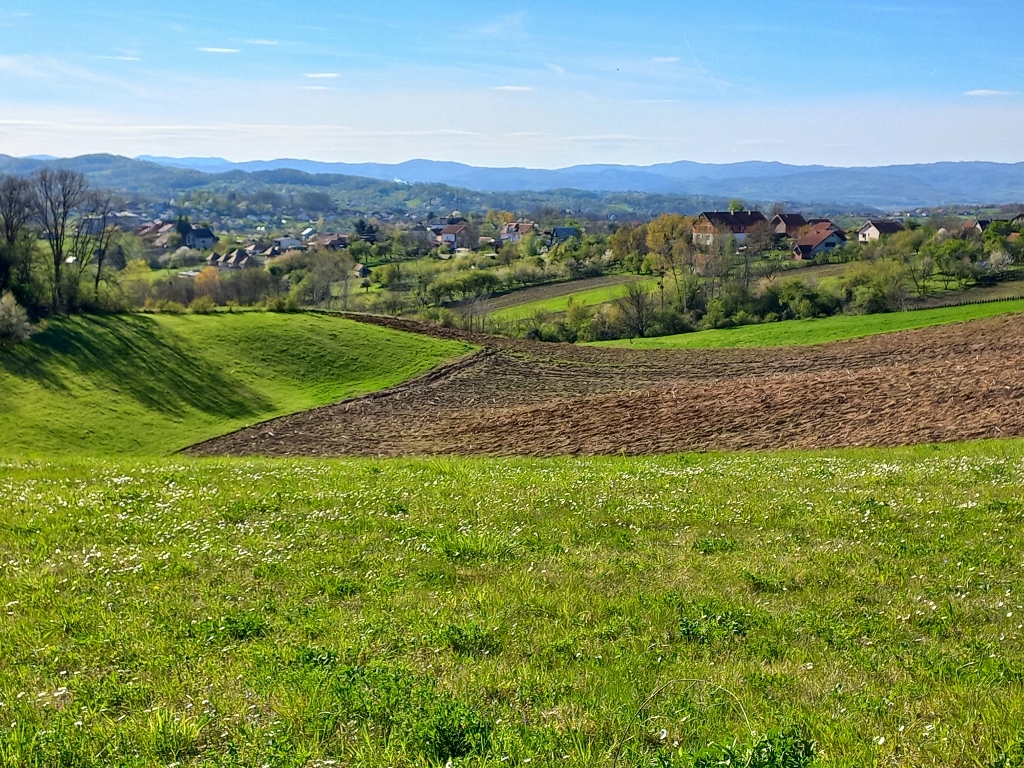 Landscapes between Tršić and Tronoša Monastery
Landscapes between Tršić and Tronoša Monastery
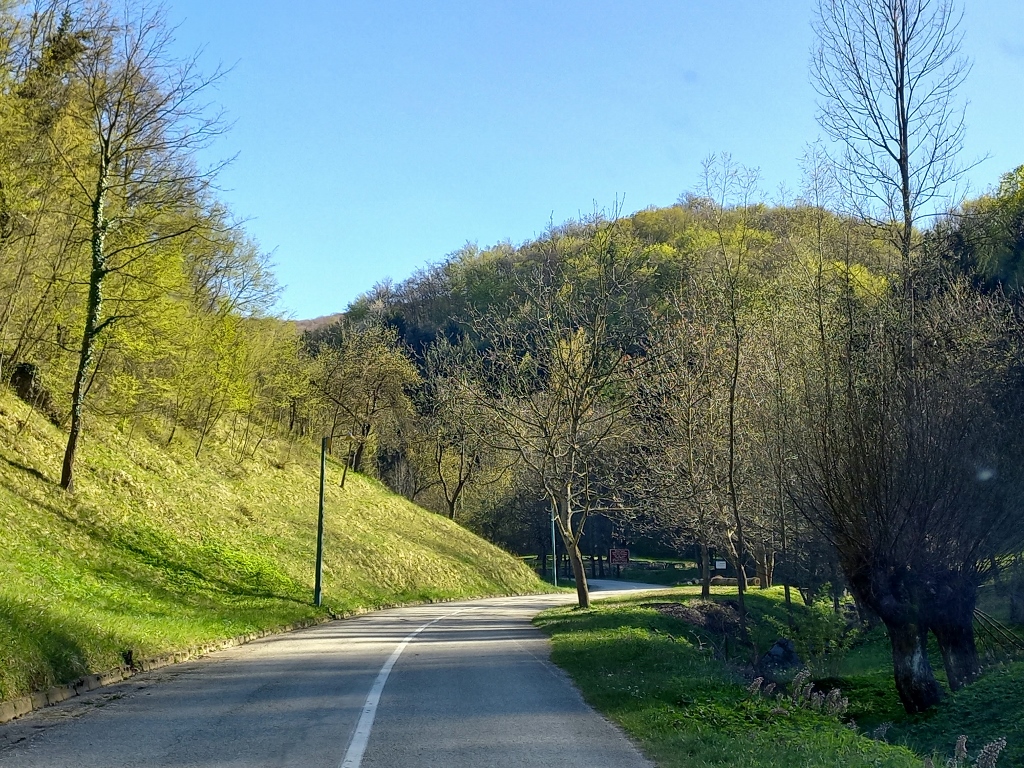 Landscapes between Tršić and Tronoša Monastery
Landscapes between Tršić and Tronoša Monastery
Soon I reached Tronoša Monastery (манастир Троноша) and I parked there. There is a small stream cascading near the monastery.
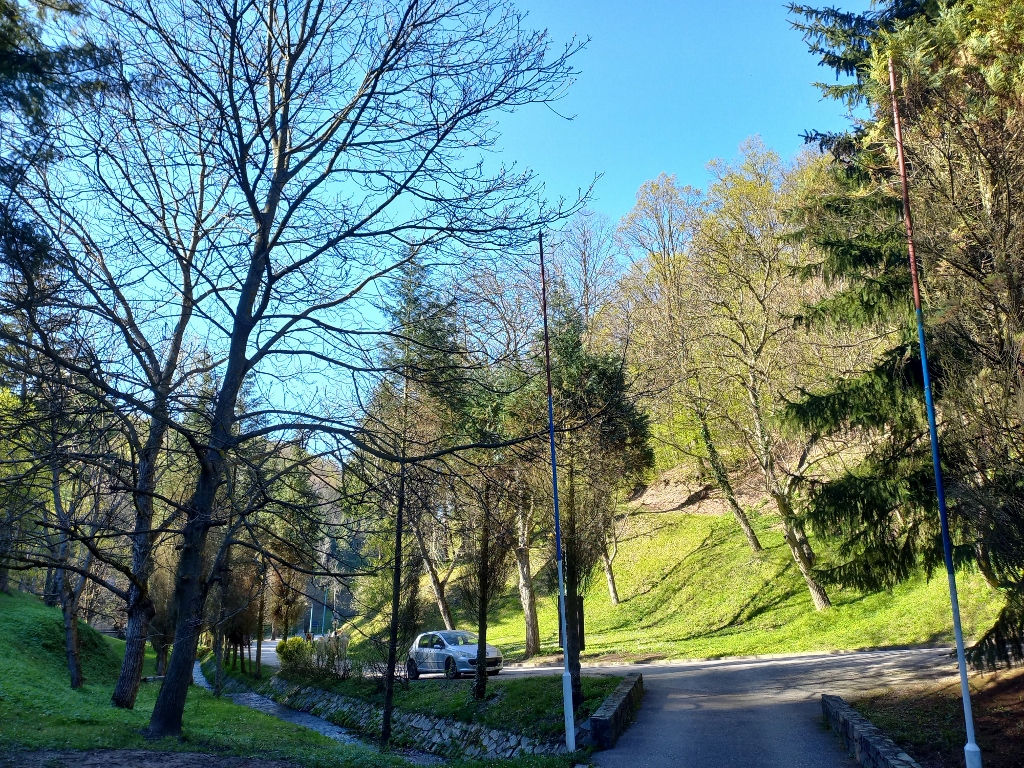 Landscape near Tronoša Monastery
Landscape near Tronoša Monastery
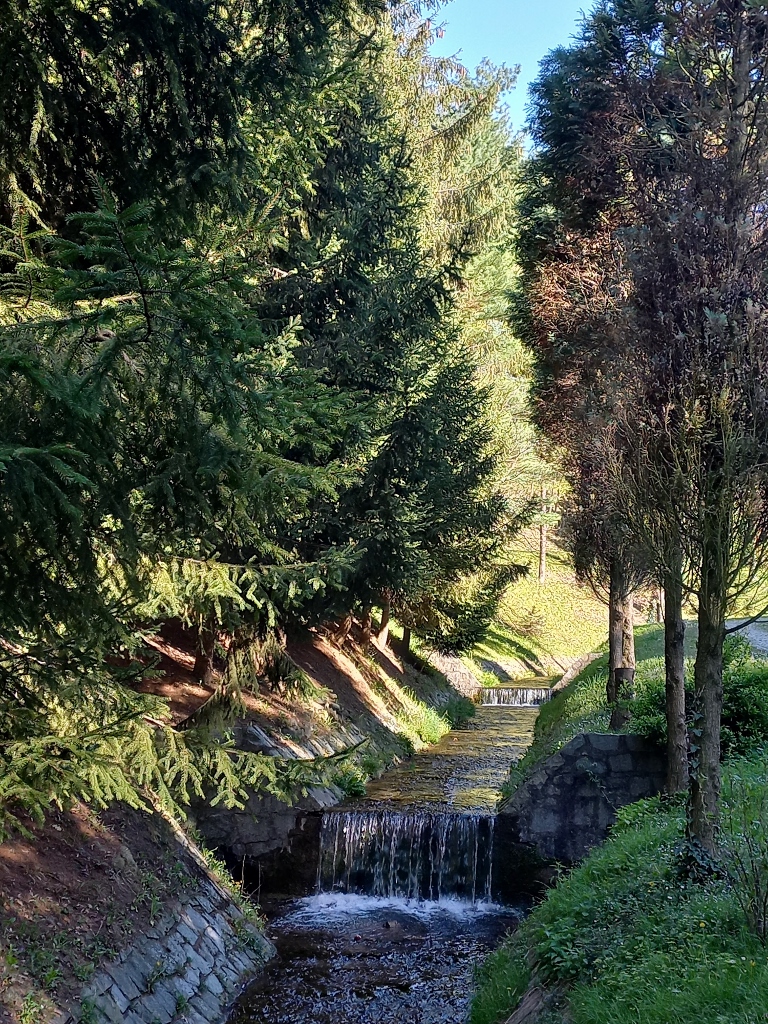 Stream near Tronoša Monastery
Stream near Tronoša Monastery
When you enter the yard, you see the church right away, but there is not enough space to take a photo of the entire church. One needs to go to the other side and only from there it is possible to view the church as a whole.
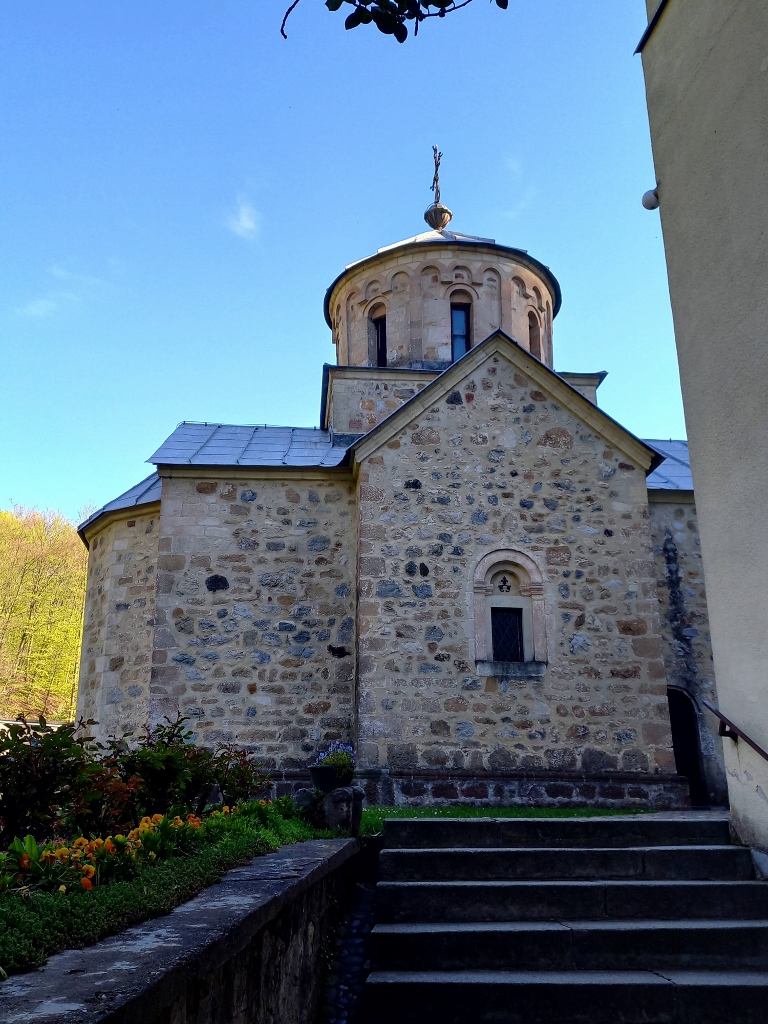 Tronoša Monastery
Tronoša Monastery
Tronoša Monastery is a monument of culture of great importance. It is believed that the original monastery was founded here between 1276 and 1282, and that the ktetor was the wife of King Dragutin, Queen Catherine of Serbia (around 1256-after 1315), formerly a Hungarian princess. This monastery church was razed to the ground by the Ottomans in the 15th century and when the monastery was restored a century later, a new church was also built and dedicated to the Entrance of the Theotokos into the Temple. The construction of the church was completed in 1559.
This is a single-nave building with a transept, a five-sided altar apse in the east and a narthex on the west side. Above the intersection of the naos and the transept there is a dome with eight fields. The church itself was designed in line with the Raška architectural school, but in the 19th century, a tall stone Baroque bell tower was added and this perhaps deviates a little from a harmony of style.
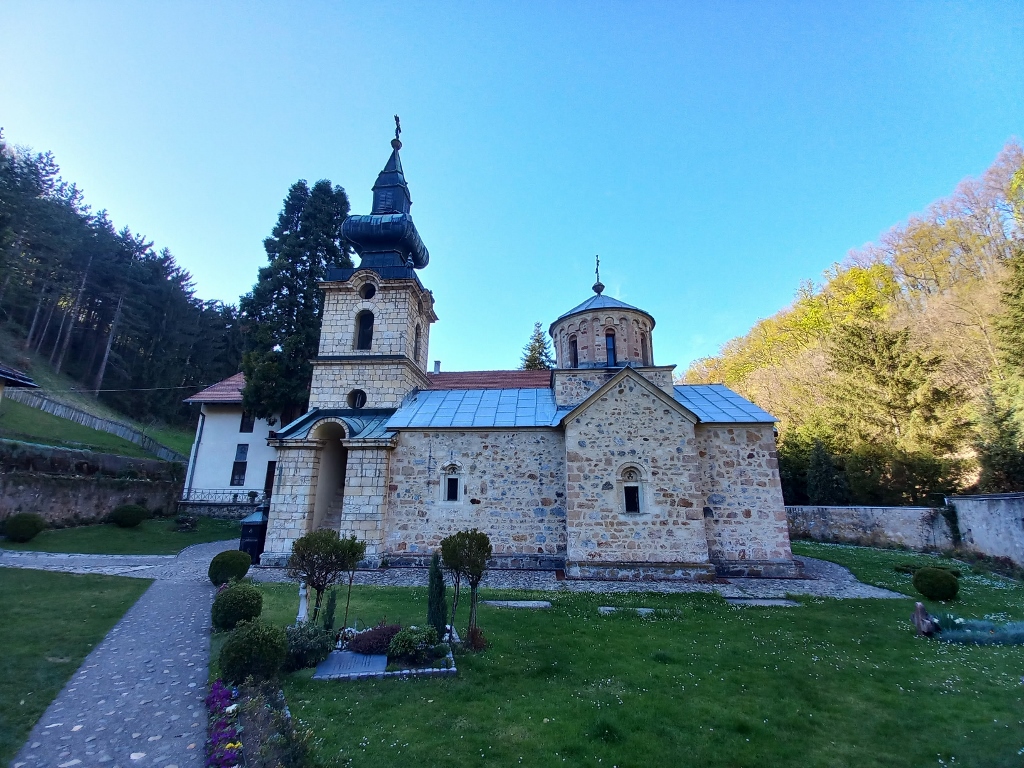 Tronoša Monastery, Church of the Entrance of the Theotokos into the Temple
Tronoša Monastery, Church of the Entrance of the Theotokos into the Temple
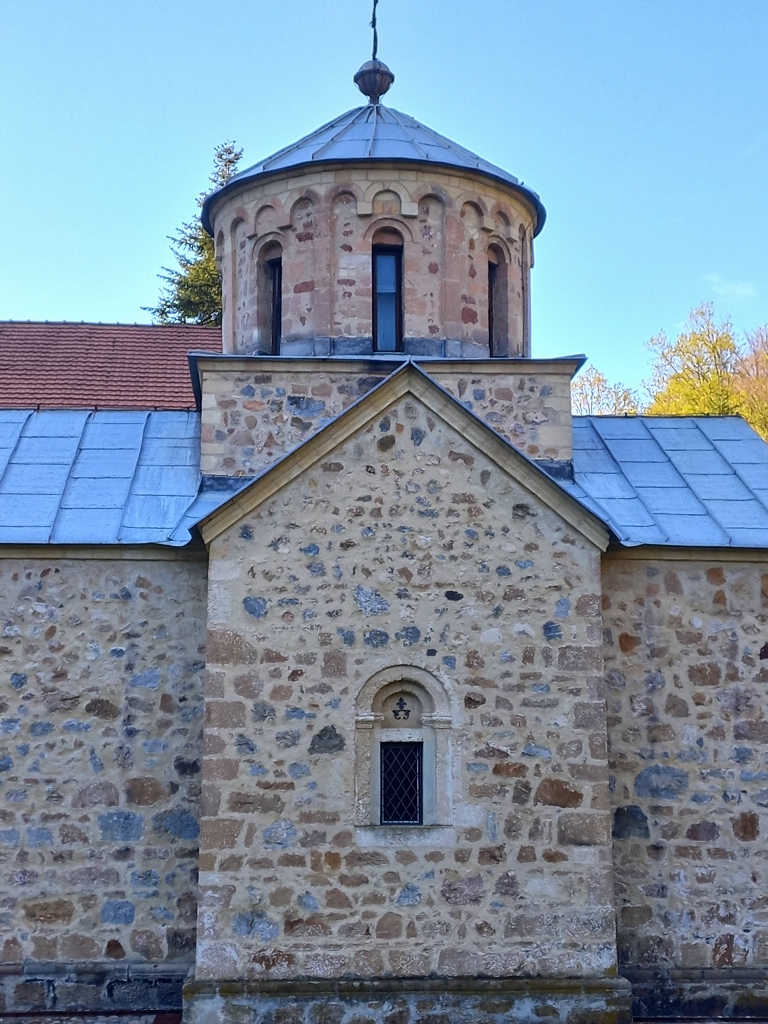 Church of the Entrance of the Theotokos into the Temple, a detail
Church of the Entrance of the Theotokos into the Temple, a detail
As for the interior, the church was fresco-painted on two occasions – in the 16th century and in 1834. The 16th-century frescoes have been preserved only in fragments on the west wall of the narthex, while the wood-carving and most of the icons placed on the iconostasis were created in the same year as the second series of the frescoes.
When I first entered the church, it was quite dark, so I had to be careful lest I tripped and fell, but then a nun came and she turned on the lights.
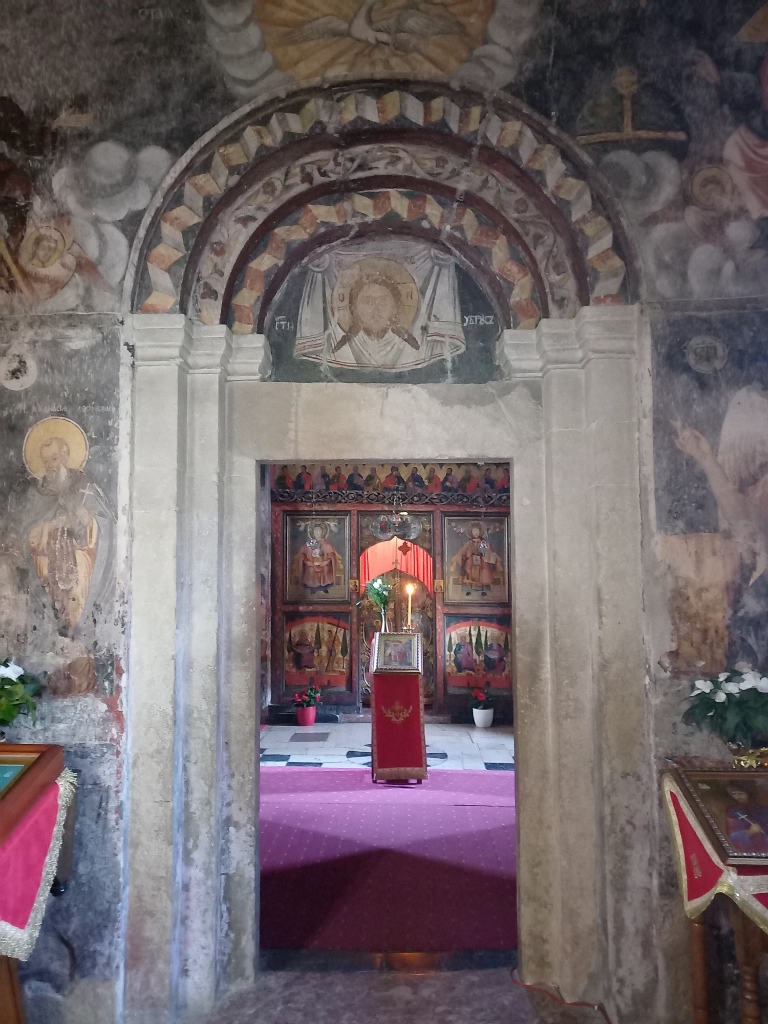 Church of the Entrance of the Theotokos into the Temple, a detail
Church of the Entrance of the Theotokos into the Temple, a detail
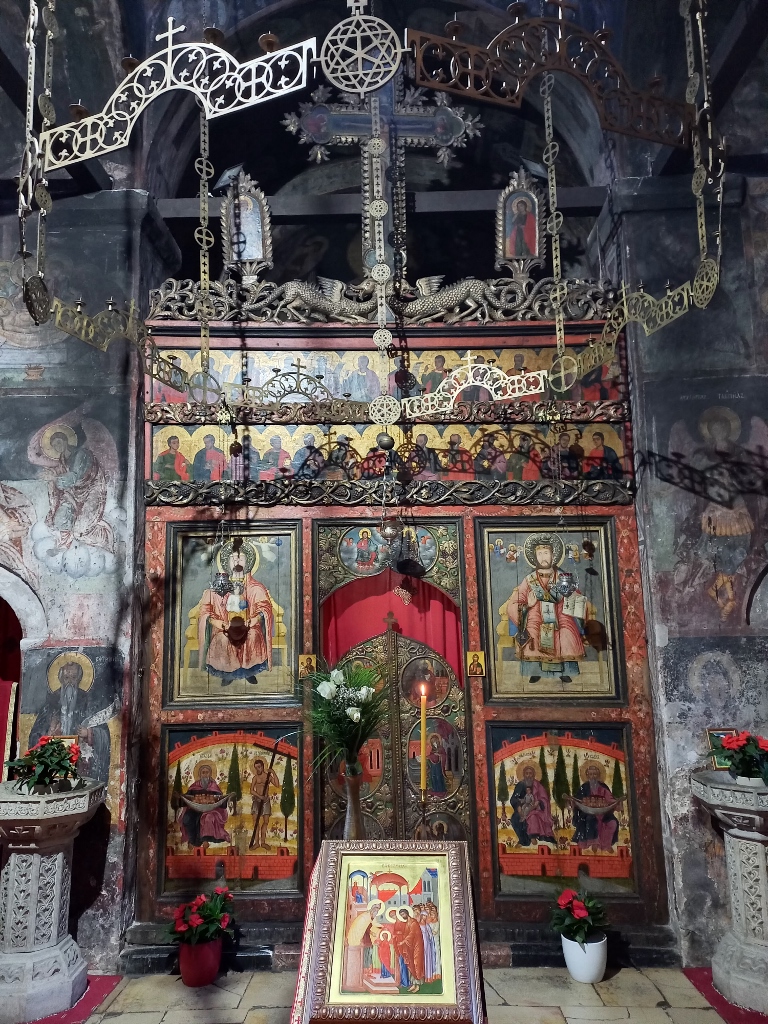 Church of the Entrance of the Theotokos into the Temple, a detail
Church of the Entrance of the Theotokos into the Temple, a detail
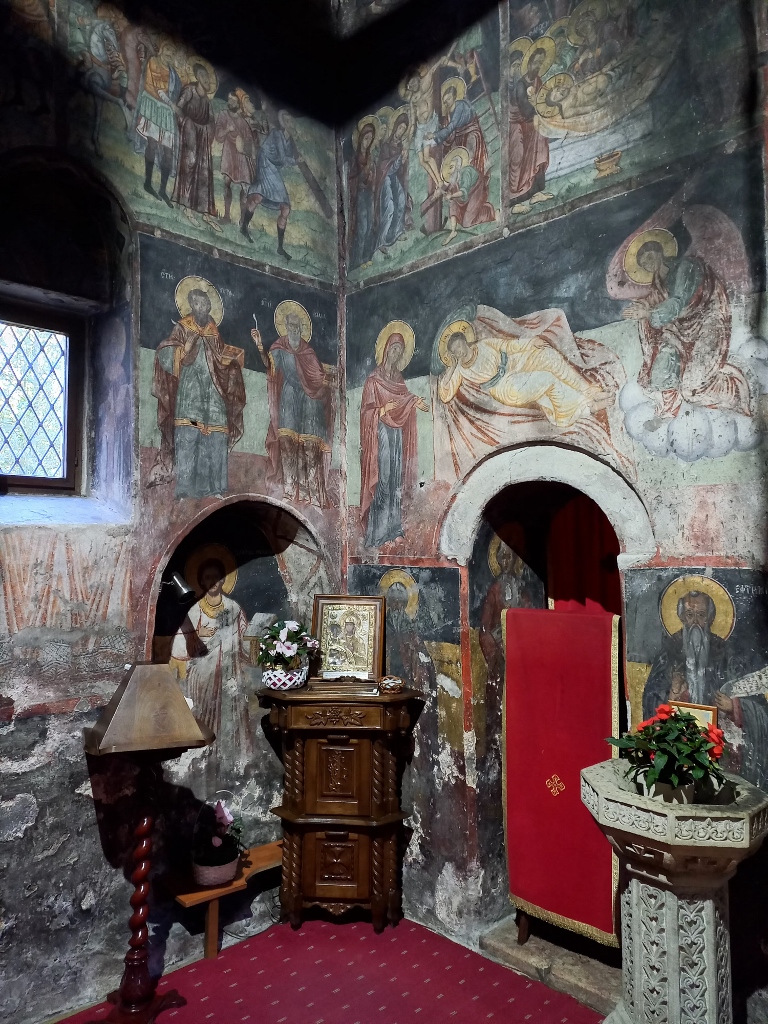 Church of the Entrance of the Theotokos into the Temple, a detail
Church of the Entrance of the Theotokos into the Temple, a detail
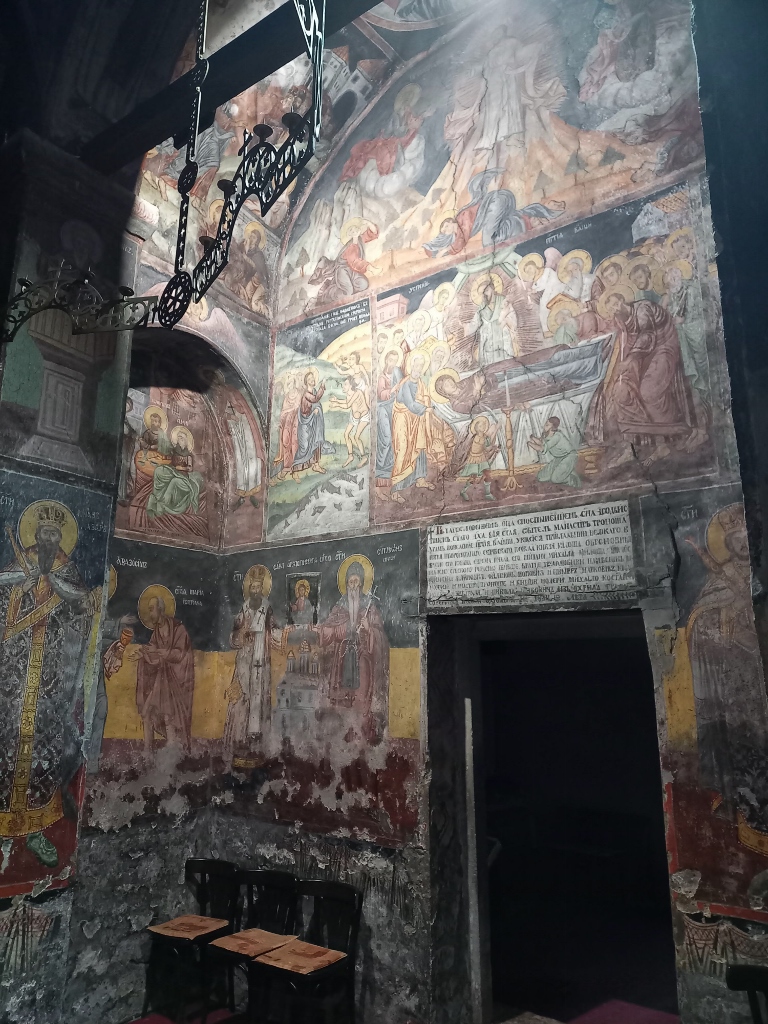 Church of the Entrance of the Theotokos into the Temple, a detail
Church of the Entrance of the Theotokos into the Temple, a detail
Once I finished with the visit to the church, I went again to the wider section of the churchyard and then I even got out through a gate in that area in order to have a better view at the church and the monastery.
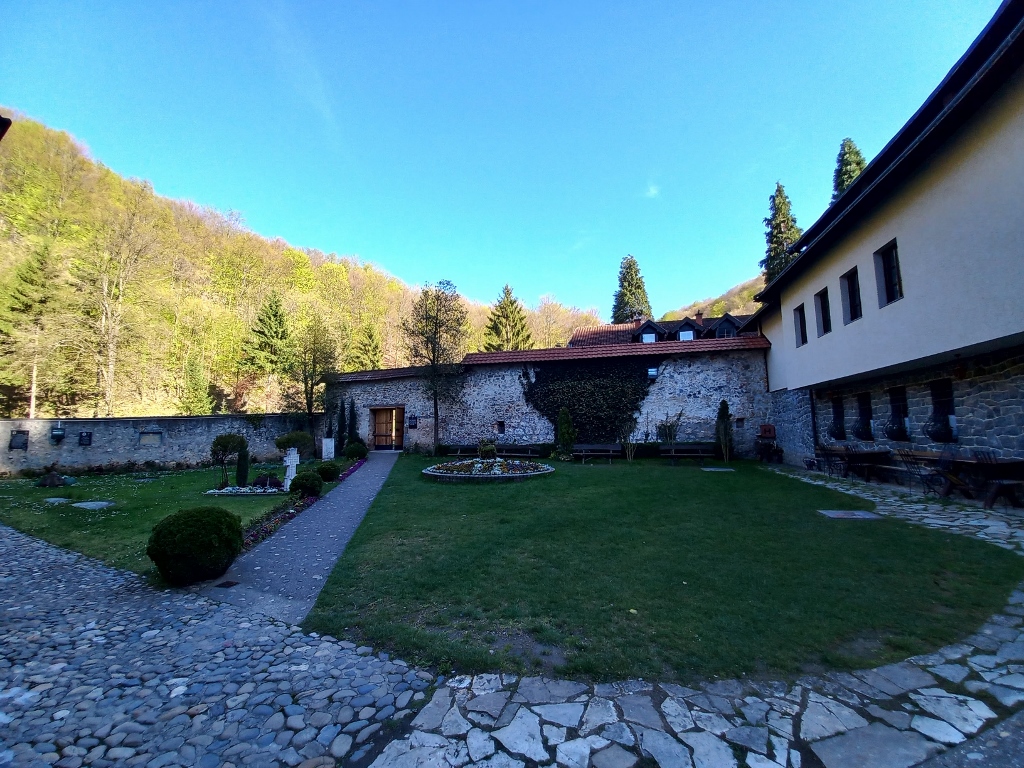 Church of the Entrance of the Theotokos into the Temple, a detail
Church of the Entrance of the Theotokos into the Temple, a detail
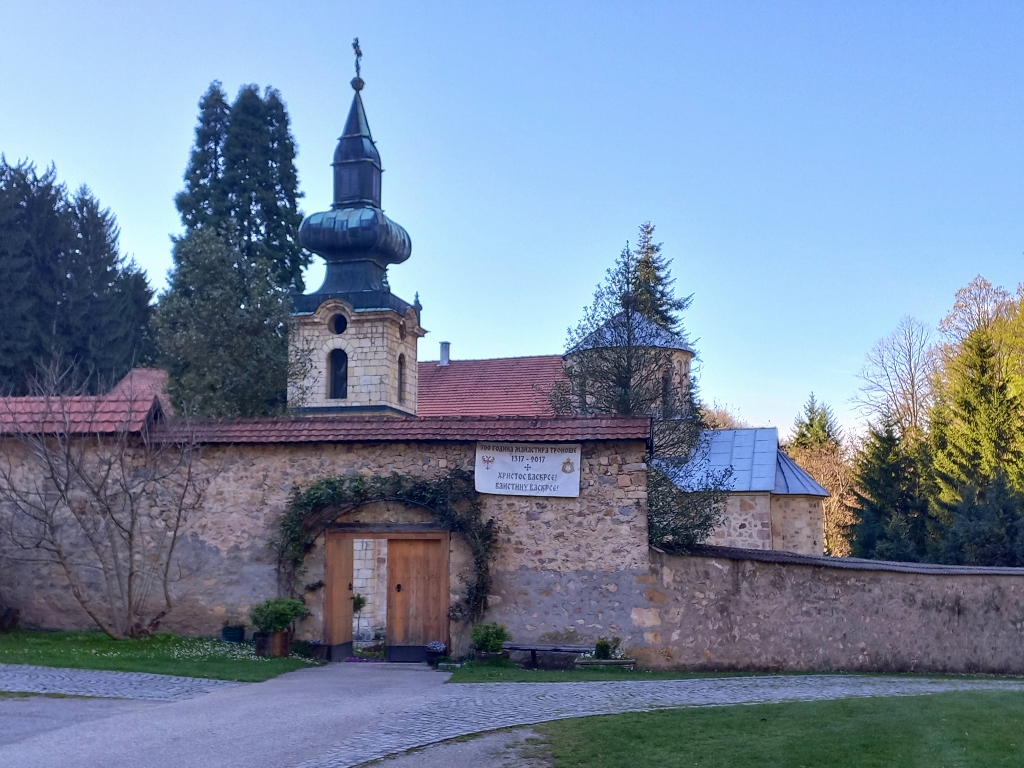 Church of the Entrance of the Theotokos into the Temple, a detail
Church of the Entrance of the Theotokos into the Temple, a detail
Before leaving Tronoša Monastery, I bought a few things at the monastery’s shop and I also noticed a wooden plaque that horrified me. The text reads: “The visitors are kindly asked not to throw cigarette buds in the yard of the monastery.”
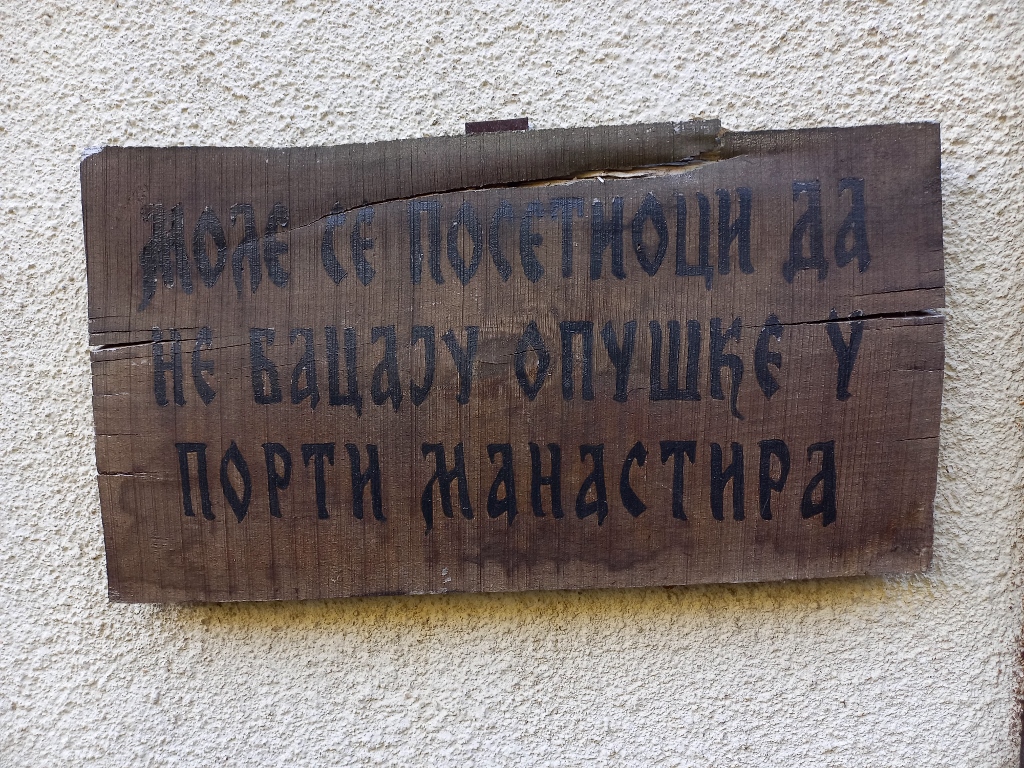 Church of the Entrance of the Theotokos into the Temple, a detail
Church of the Entrance of the Theotokos into the Temple, a detail
How can anybody enter the yard of a monastery while smoking or light a cigarette there? Tronoša Monastery is relatively tucked away from the main traffic and even tourist routes, so I presume that most of the visitors are people who consider themselves to be true believers. Hmmm...
I was here on Holy Wednesday, in other words, a day before Maundy Thursday, but I did not regret not coming here for the big feast, since I’m sure that it was very crowded then. Namely, for centuries now, every year on Maundy Thursday, the monastery is given two candles made of pure beeswax that are around 1.5 m tall, with the diameter of 20 cm and the weight of around 50 kg. They are then placed at the monastery. These are the gifts from the residents of the surrounding villages. The candles are lit on Sundays and feast days, for health, happiness, as well as for the protection of fields and better yields and for this reason they are called “farmer candles.”
A couple of hundred metres before Tronoša Monastery, beside the road that leads to the monastery, there is the Chapel of St. Pantaleon with the Drinking Fountain of Nine Jugović Brothers.
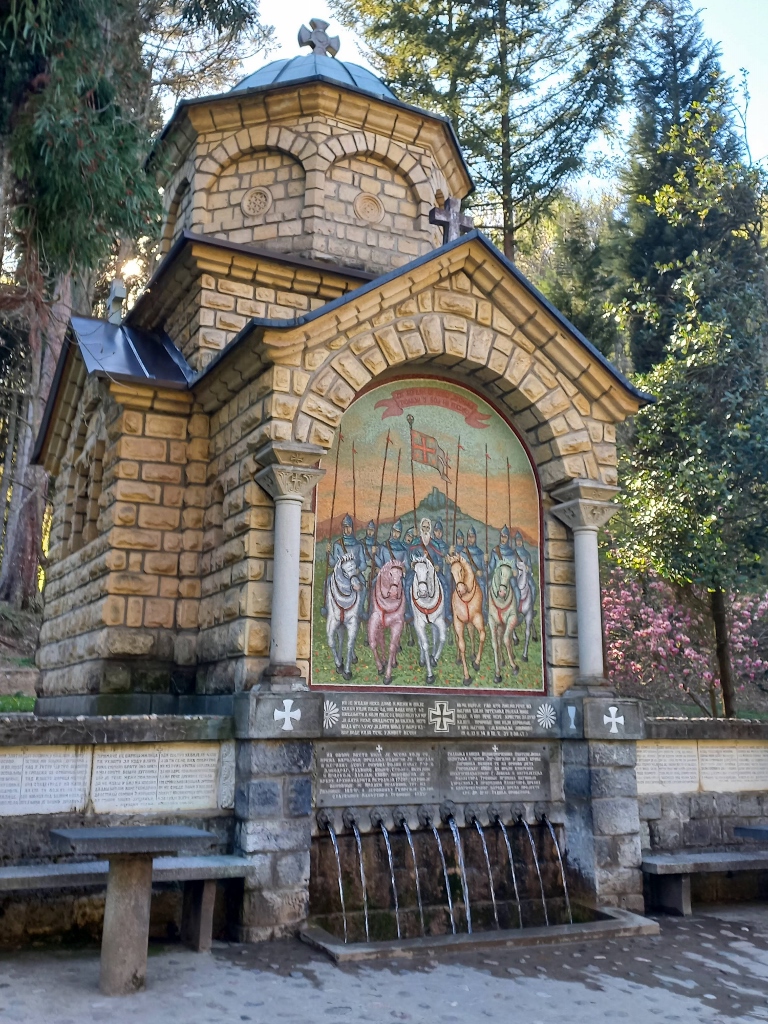 Chapel of St. Pantaleon with the Drinking Fountain of Nine Jugović Brothers
Chapel of St. Pantaleon with the Drinking Fountain of Nine Jugović Brothers
According to the legend, the fountain was built in 1388, a year before the Battle of Kosovo (1389), by Jug Bogdan and his sons (these are legendary Serbian heroes from the time of the Battle), and this is where they spent the night and drank from before going to the battle. The fountain was first restored in 1721 and it was also restored later, in the 19th and the 20th centuries. The chapel and the fountain that can be seen here today date back to 1968. The fountain has 10 water pipes with strong throughflow, one is stronger and bigger than the rest of them, thus symbolising Jug Bogdan and nine Jugović brothers, his sons.
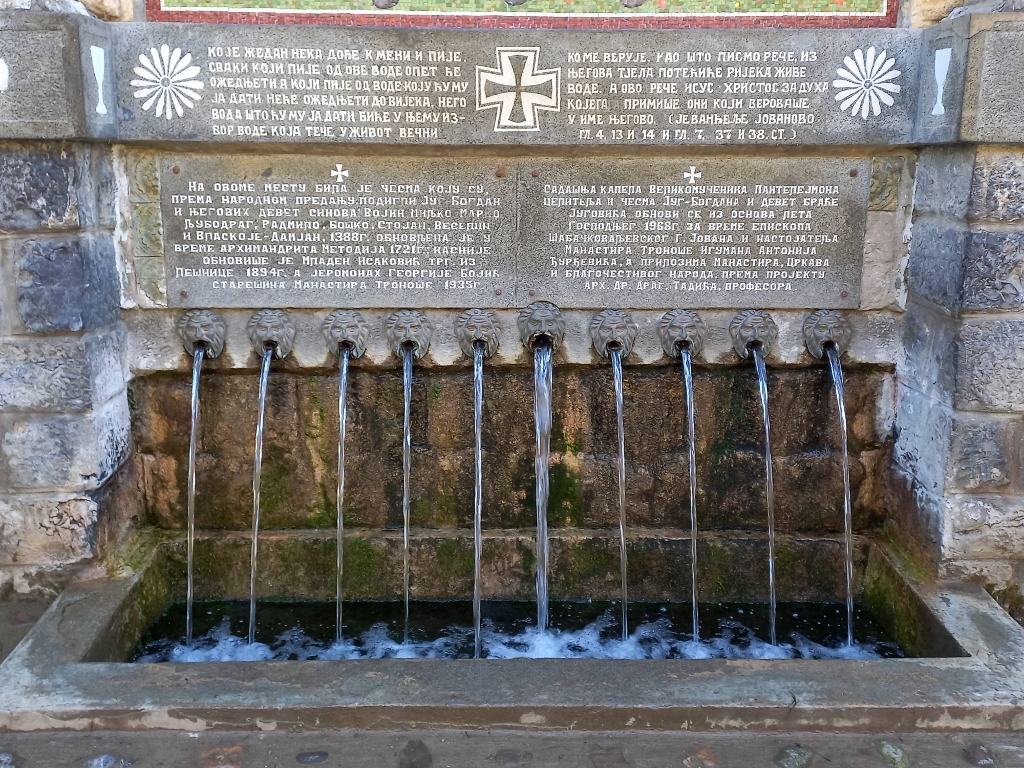 Drinking Fountain of Nine Jugović Brothers
Drinking Fountain of Nine Jugović Brothers
The water from the fountain is potable and can be taken from here in unlimited quantities, since it flows incessantly.
As for the chapel, it is entered from the west side and it is fresco-painted, while there are also slabs with the names of the donors.
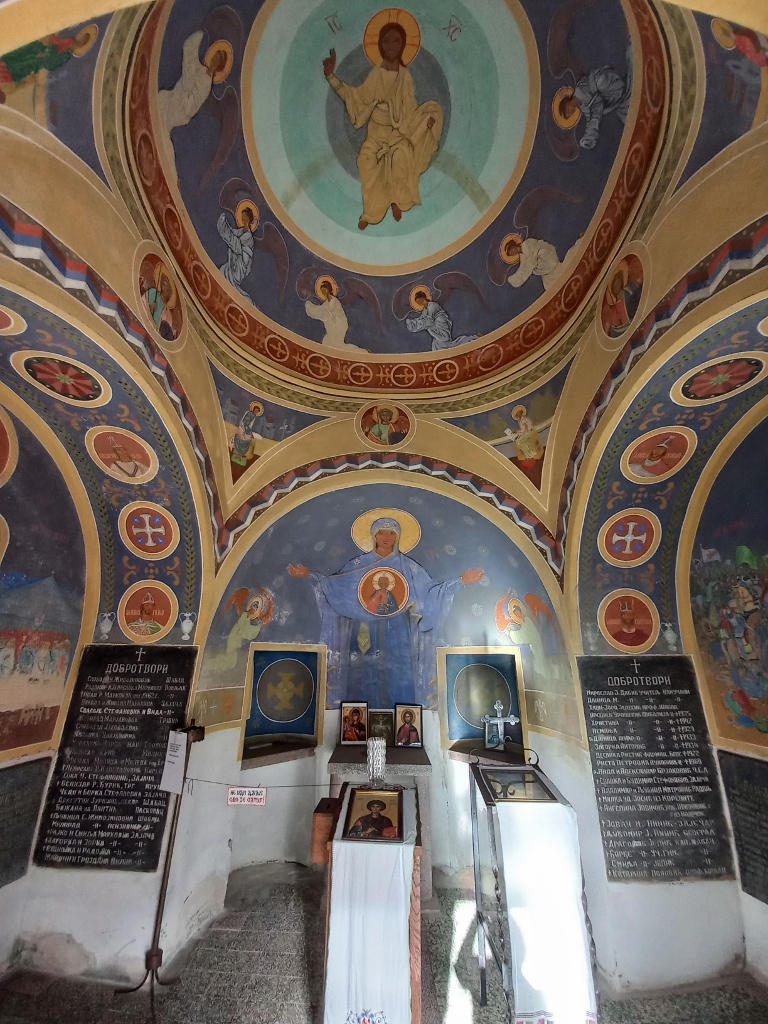 Chapel of St. Pantaleon, the interior
Chapel of St. Pantaleon, the interior
Although the surroundings of Tronoša Monastery were already in shade since the Sun had set behind the hills there, once I got back in the direction of the main road between Loznica and Valjevo, the landscapes were still sunlit and spectacularly beautiful, while my next destination was village Draginac (Драгинац).
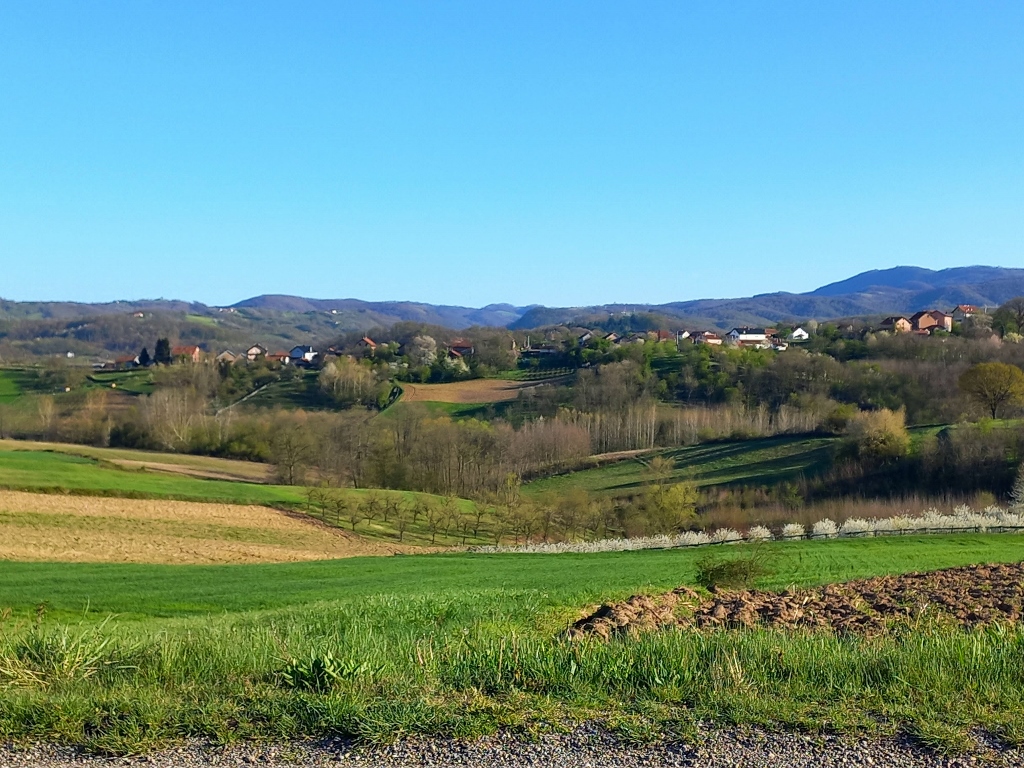 On the road from Tronoša Monastery to village Draginac
On the road from Tronoša Monastery to village Draginac
Soon after the German forces occupied Yugoslavia in 1941, a rule was introduced on the territory of Serbia that 100 Serbs were to be killed for each killed German soldier and 50 Serbs for each wounded German soldier. I don’t know if this rule applied in the other parts of the then Yugoslavia or in other countries occupied by the Germans, but the fact is that in this way the Germans tried to pacify the traditionally unpleasant and rebellious Serbs. Namely, in September 1941, Hitler appointed Austrian general Franz Böhme as the chief commander in Serbia. According to what I have read in a document, after arriving in Serbia, Böhme reminded his Austrian soldiers, now members of the German army, of the events from WWI and told them that “they can take revenge for [their] dead comrades” from 1914. I have already written in some of the previous sequels of my travel stories about the 1914 battles that were fought between Serbia and Austria-Hungary mostly right here in the area that I visited in April 2023.
Still, although he did not take part personally in the Austro-Hungarian attack on Serbia in 1914, it is obvious that Böhme had “a big trauma” linked to WWI, so only a month after taking up the office, there were several major reprisals under his command for the German soldiers killed or wounded in the skirmishes with members of the Serbian resistance movement. The most infamous massacres took place in the towns of Kragujevac and Kraljevo, but there was this as well in village Draginac near Loznica where I was heading on this day.
Somehow it seems to me that this place of the massacre of Serbian civilians in WWII has remained in the shadow of those in Kragujevac where Germans, as a sign of retaliation, killed almost 2800 civilians (including around 300 children aged 11 to the end of secondary school) and in Kraljevo where there were 2255 victims. Here in Draginac, in October 1941, 2677 civilians gathered from the surrounding villages were killed by firing squads.
Also, in WWI, the Austro-Hungarian soldiers regularly massacred civilians in this region and there are historians who claim that there was a hanged Serb on almost every tree.
I am sure that many Germans and Austrians thought and claimed at the end of the 20th century, and do so even today, that Serbs are primitive barbarians. Without any intention to diminish any crimes committed by members of my own nation, I think that this is the right situation for the words of Jesus Christ: “Let anyone among you who is without sin be the first to throw a stone at her.” Well, if only these Germans and Austrians who comment others were good Christians or if only they would keep their mouth shut.
In any case, the Memorial Ossuary in Draginac is situated quite close to the main road between Loznica and Valjevo, in a flat area, even before one gets to the centre of the village that is located on a mild elevation. I parked the car and headed for the monument following a path.
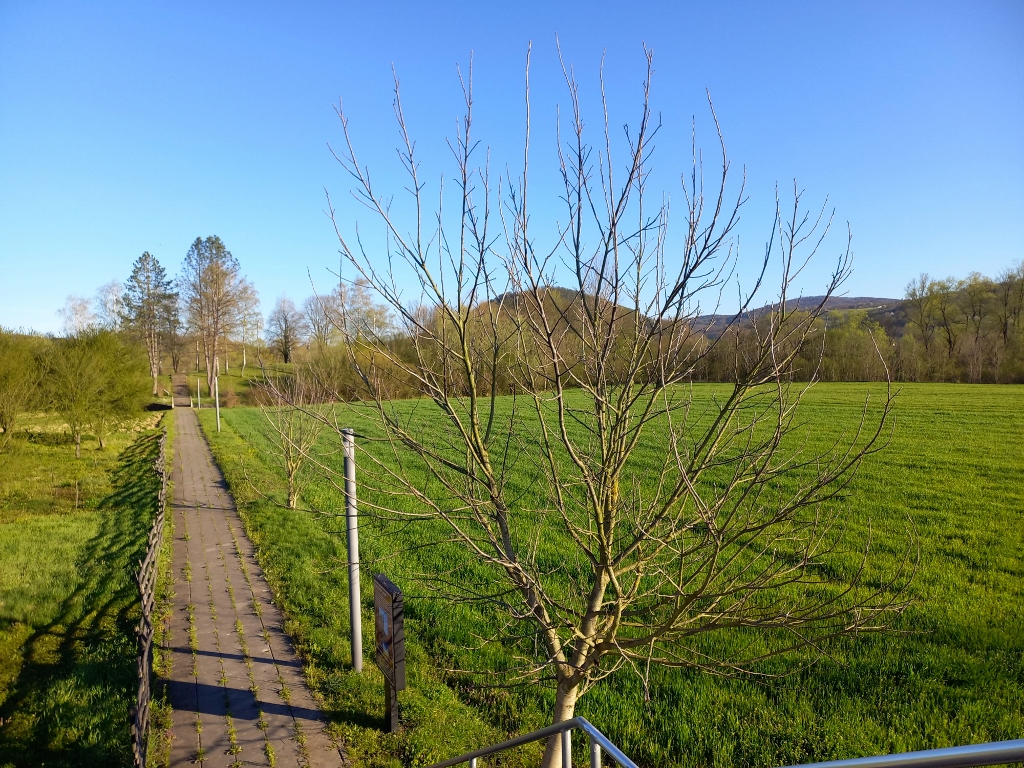 Path leading to the Memorial Ossuary in Draginac
Path leading to the Memorial Ossuary in Draginac
The Germans killed the residents of the surrounding villages in several spots and afterwards mounds with gravestones were created there, but in 1961, the remains of those killed were exhumed and transferred here to the joint tomb.
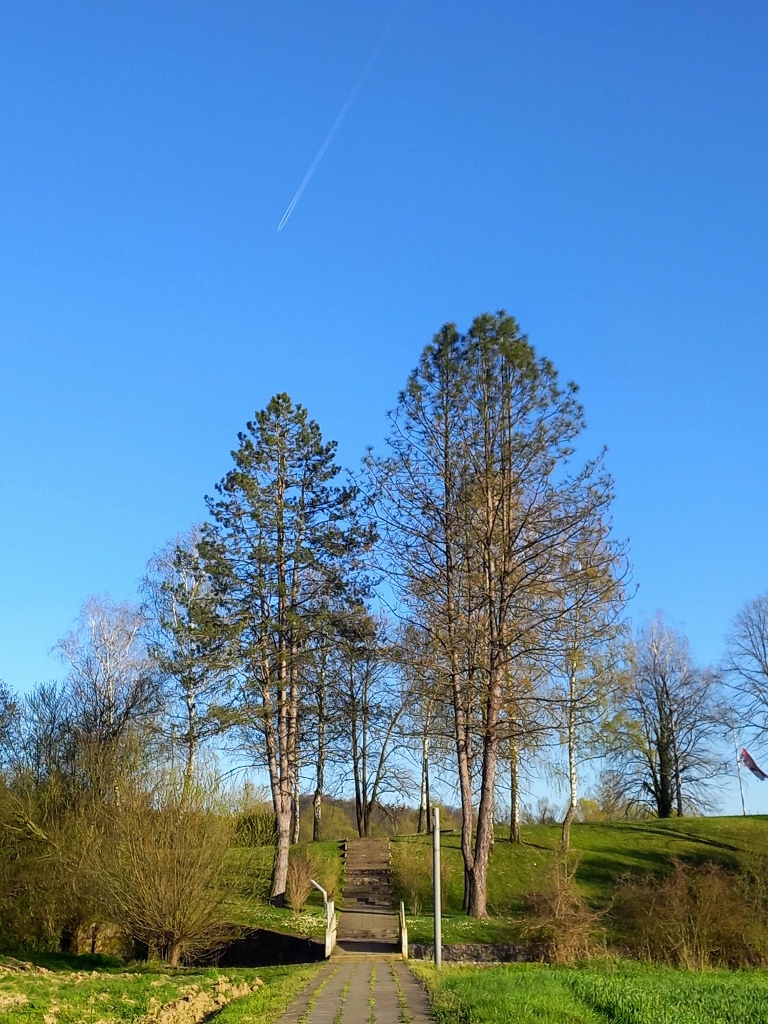 Access to the Memorial Ossuary in Draginac
Access to the Memorial Ossuary in Draginac
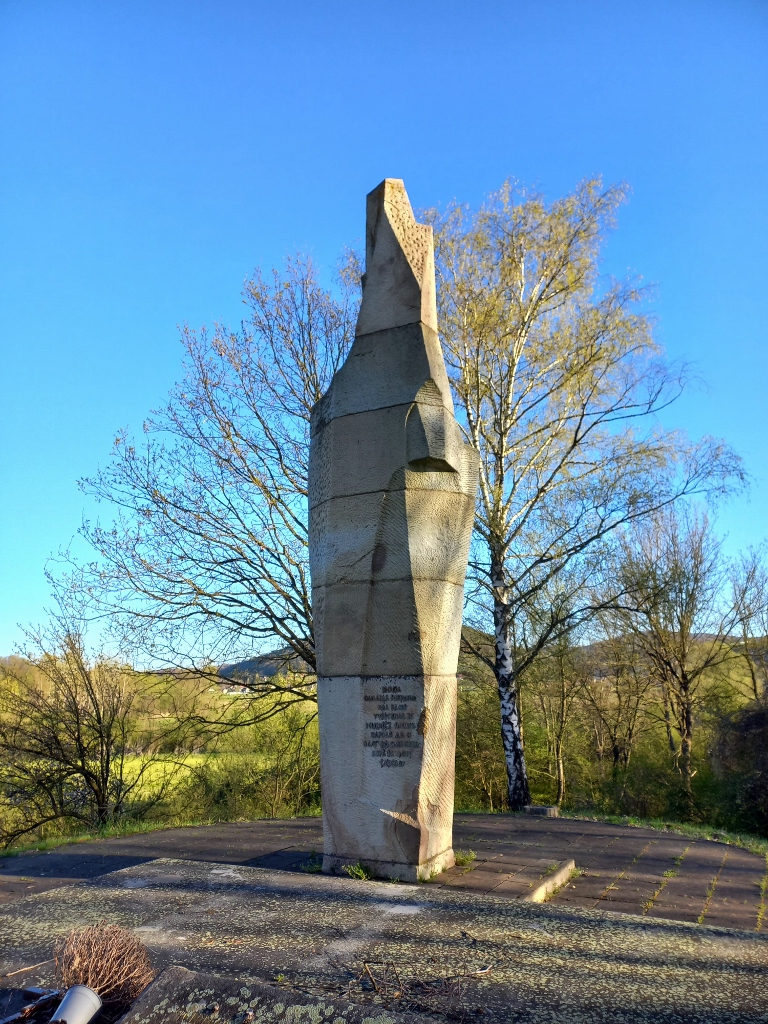 Monument above the Memorial Ossuary in Draginac
Monument above the Memorial Ossuary in Draginac
After this, I went back to Banja Koviljača where I had already finished with my medical treatments, so the following day I started to return to Belgrade.